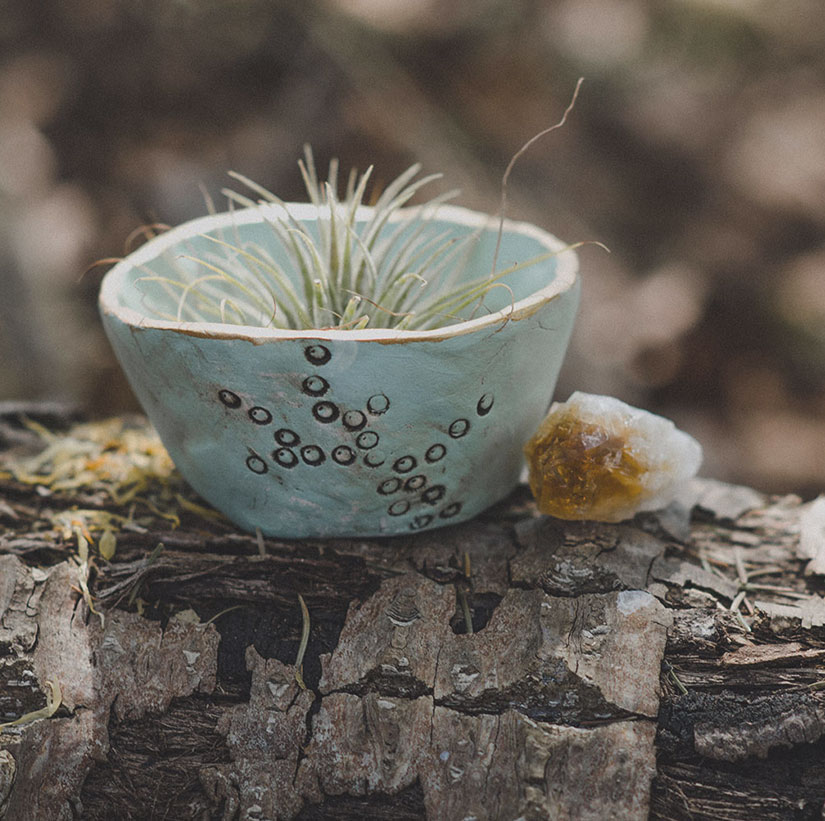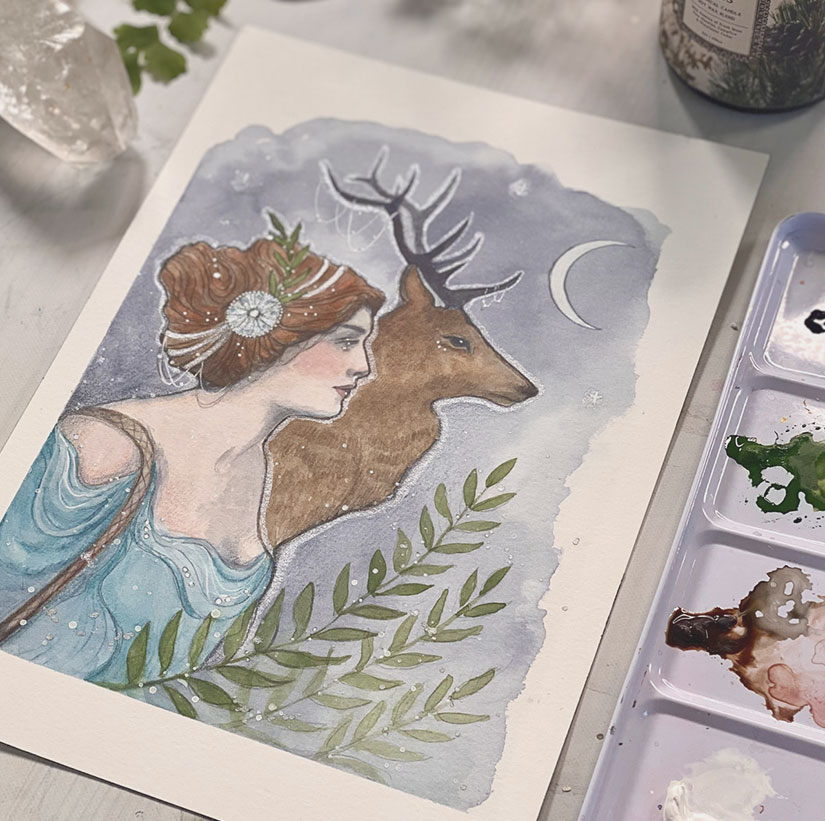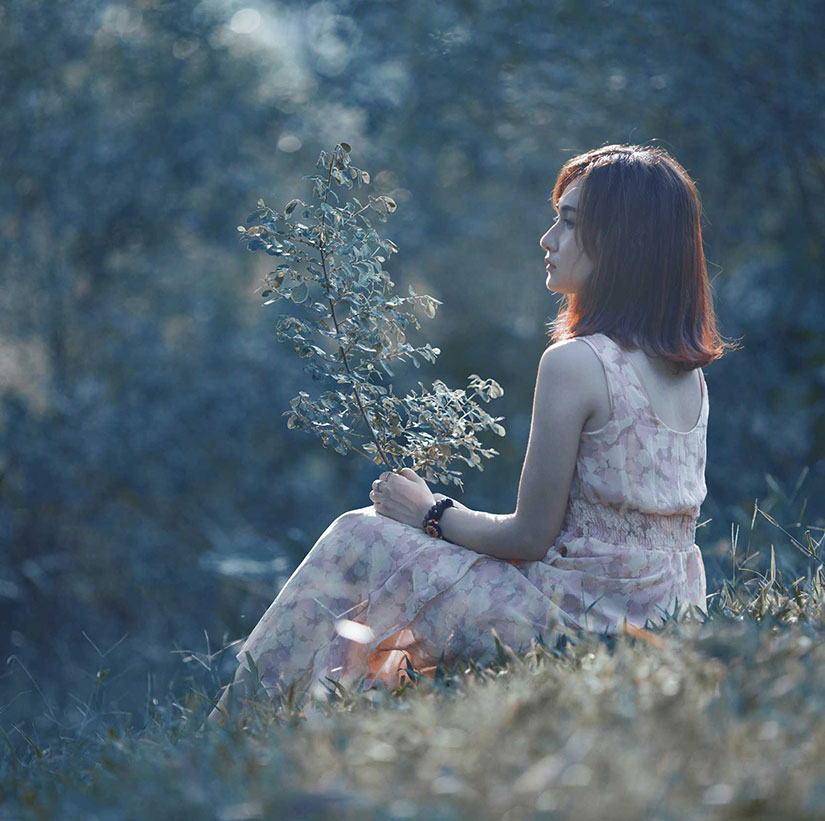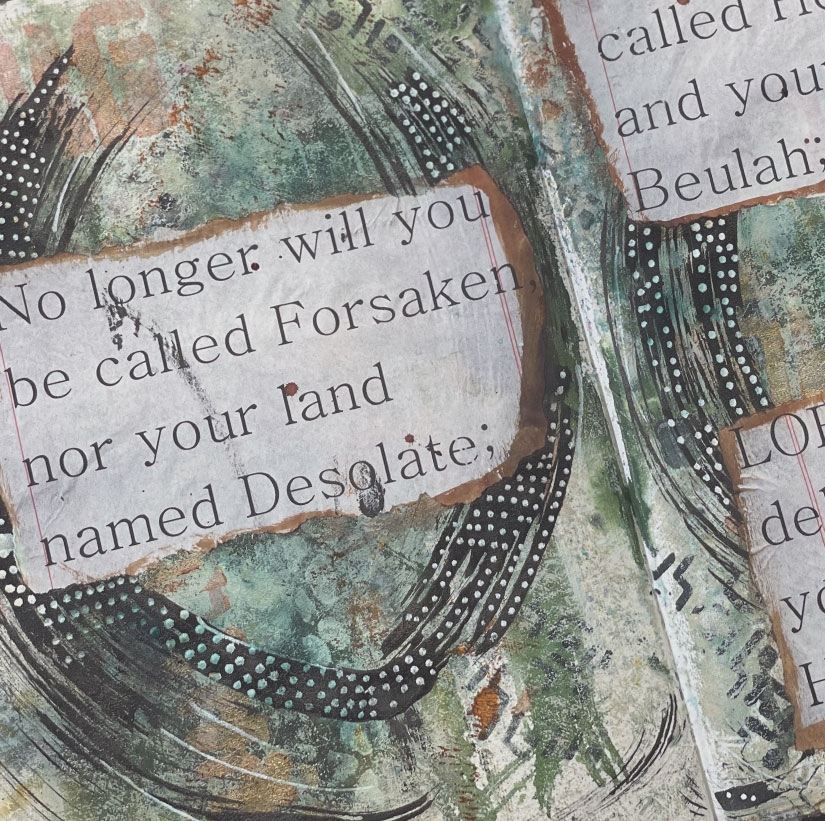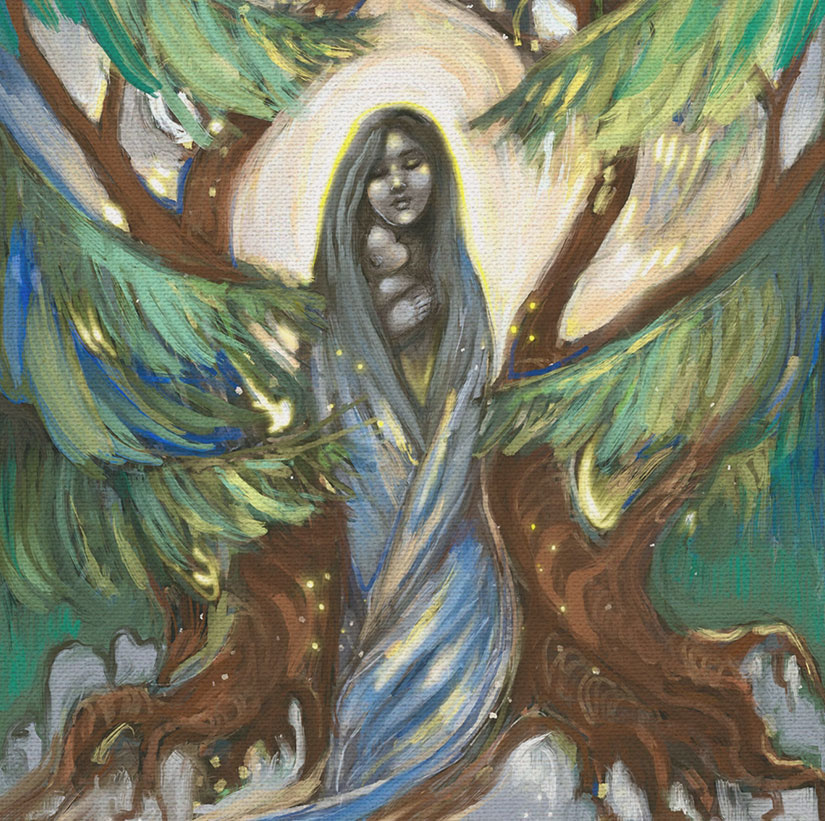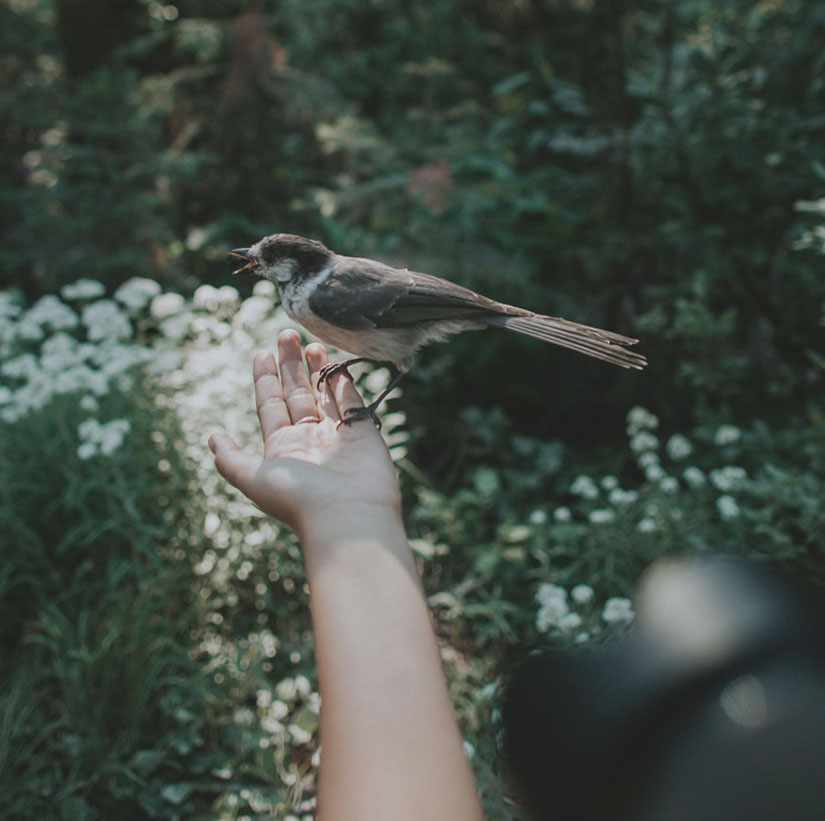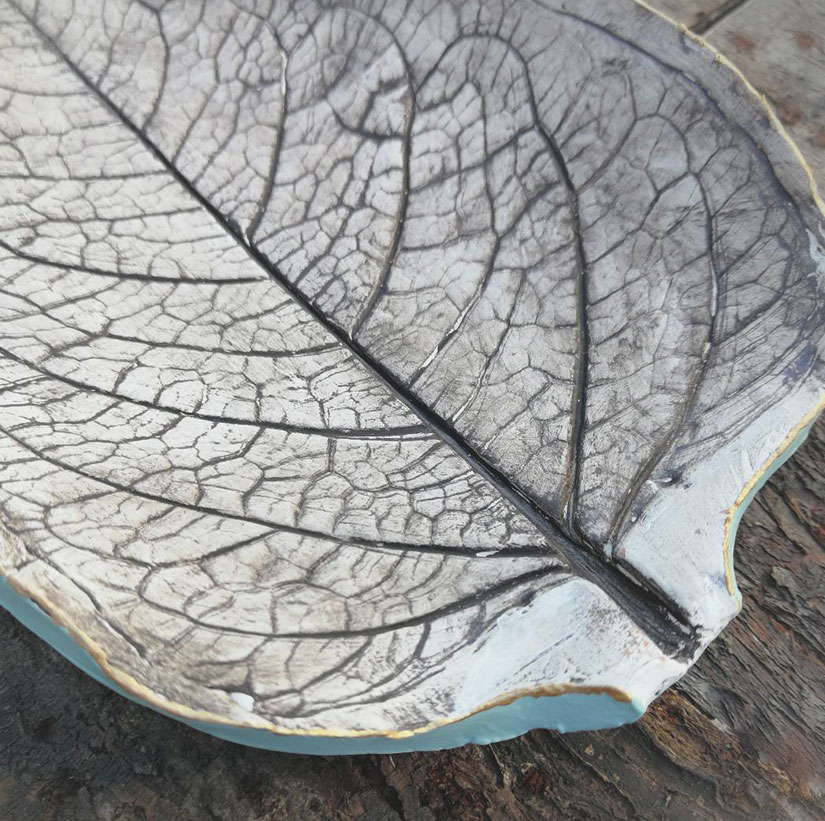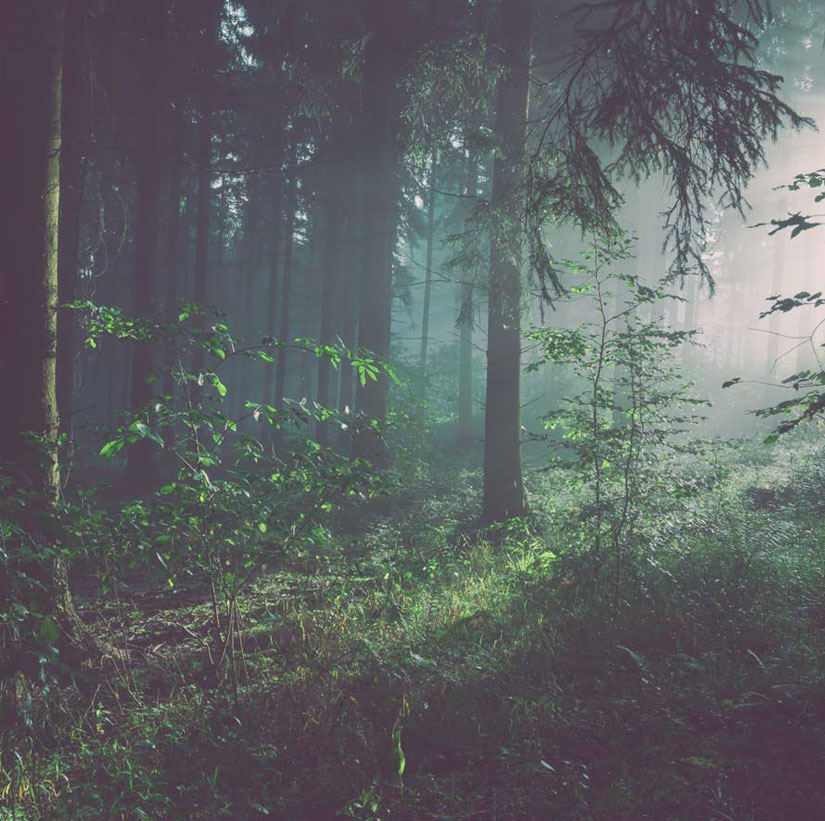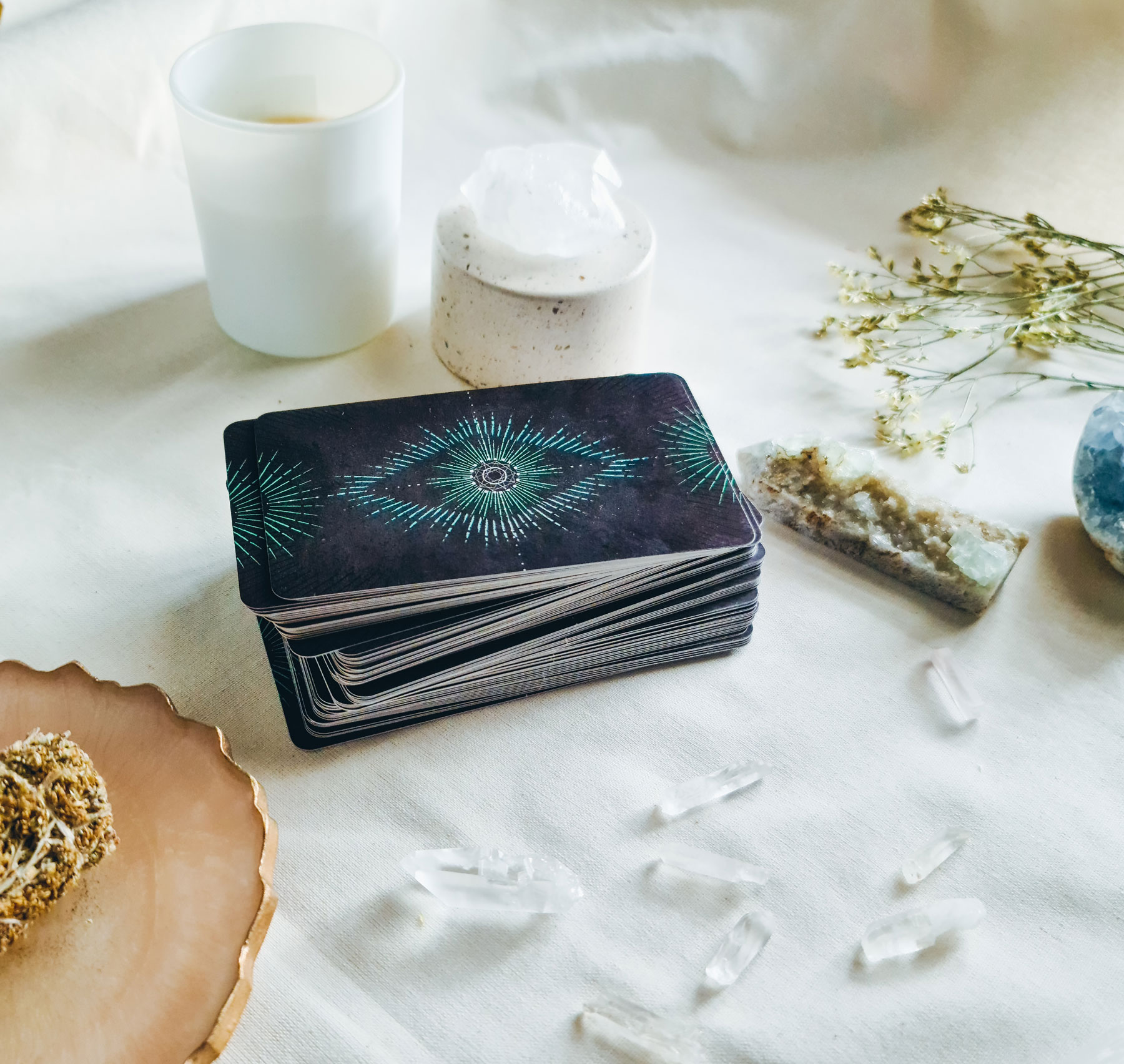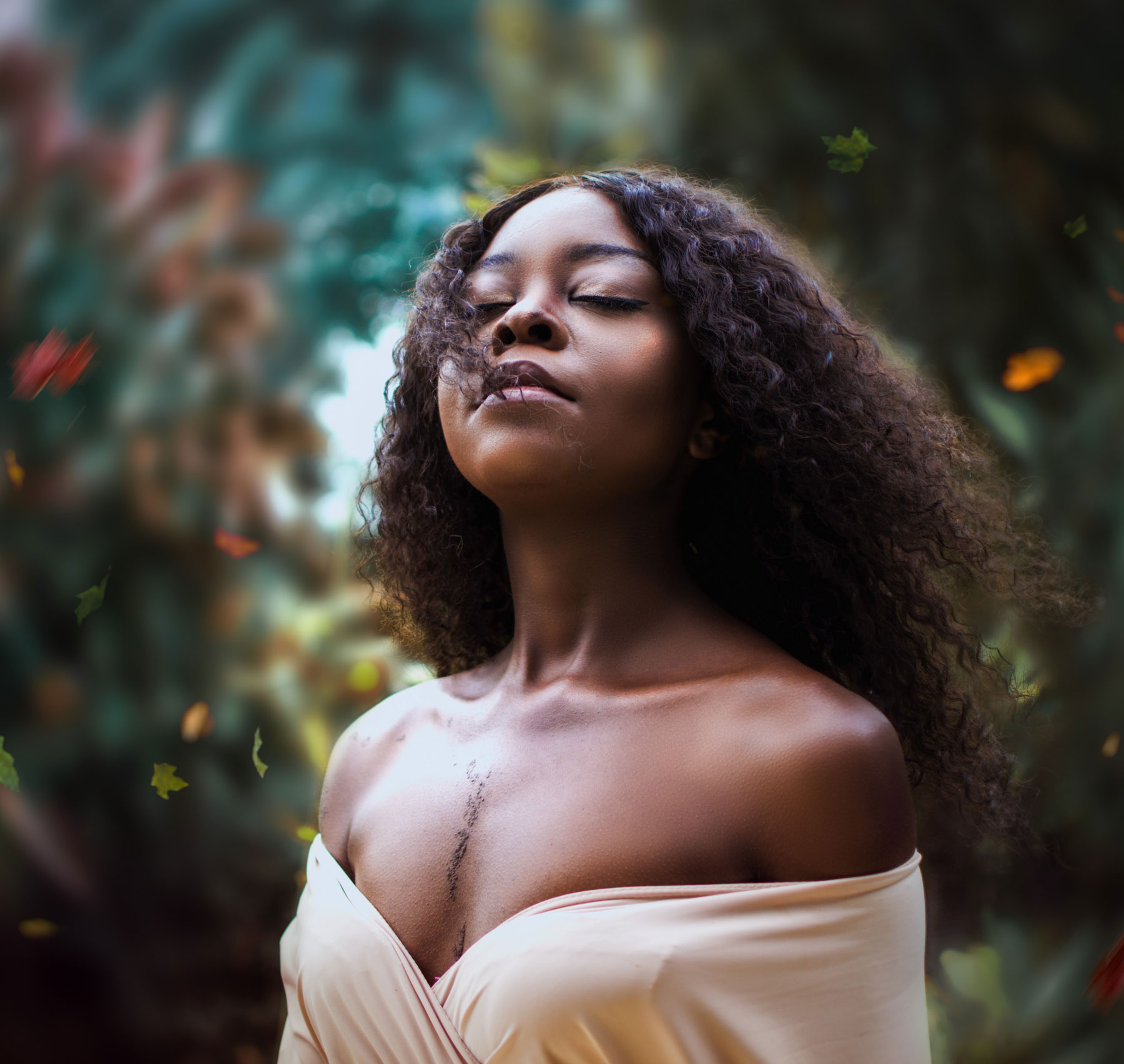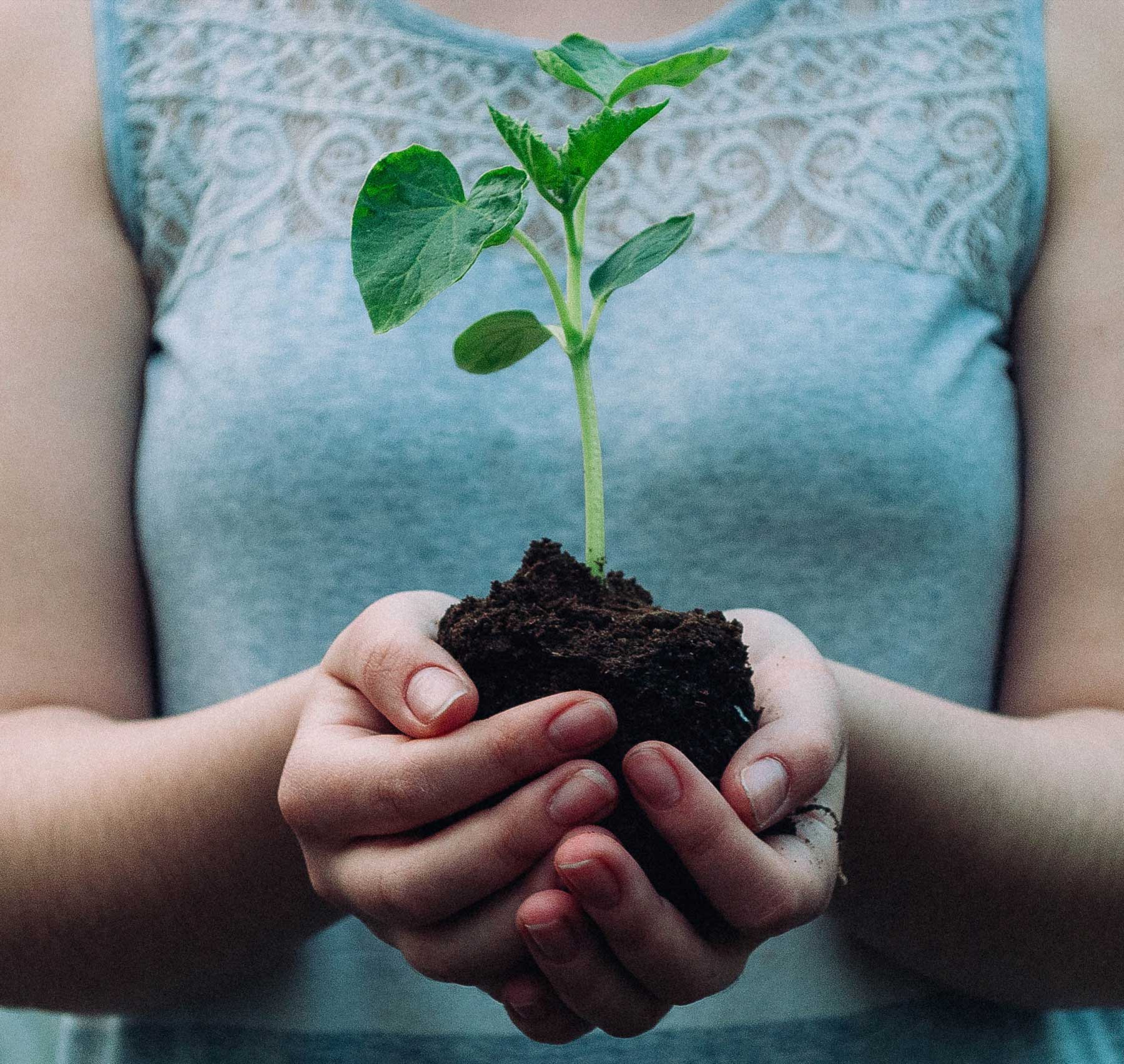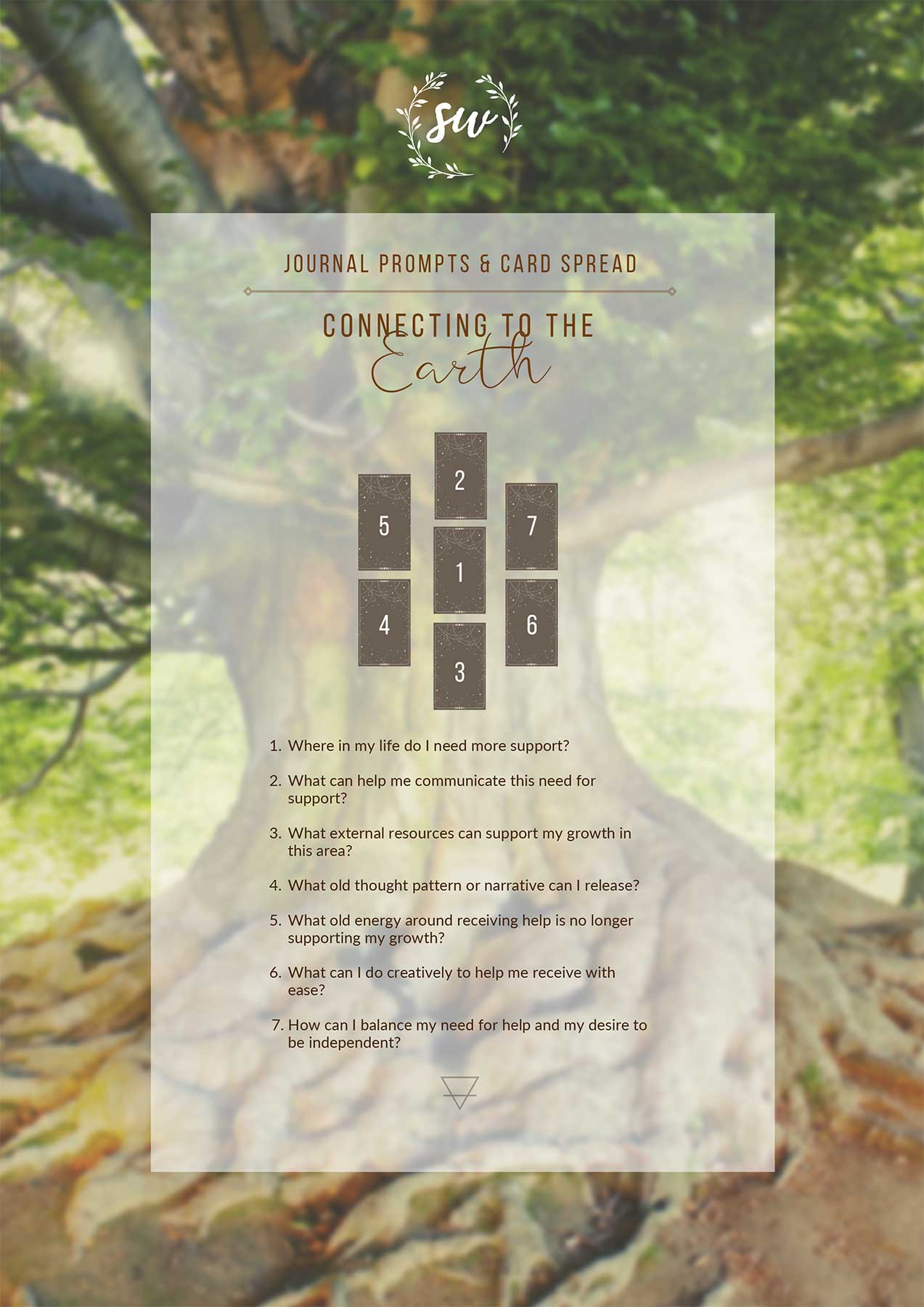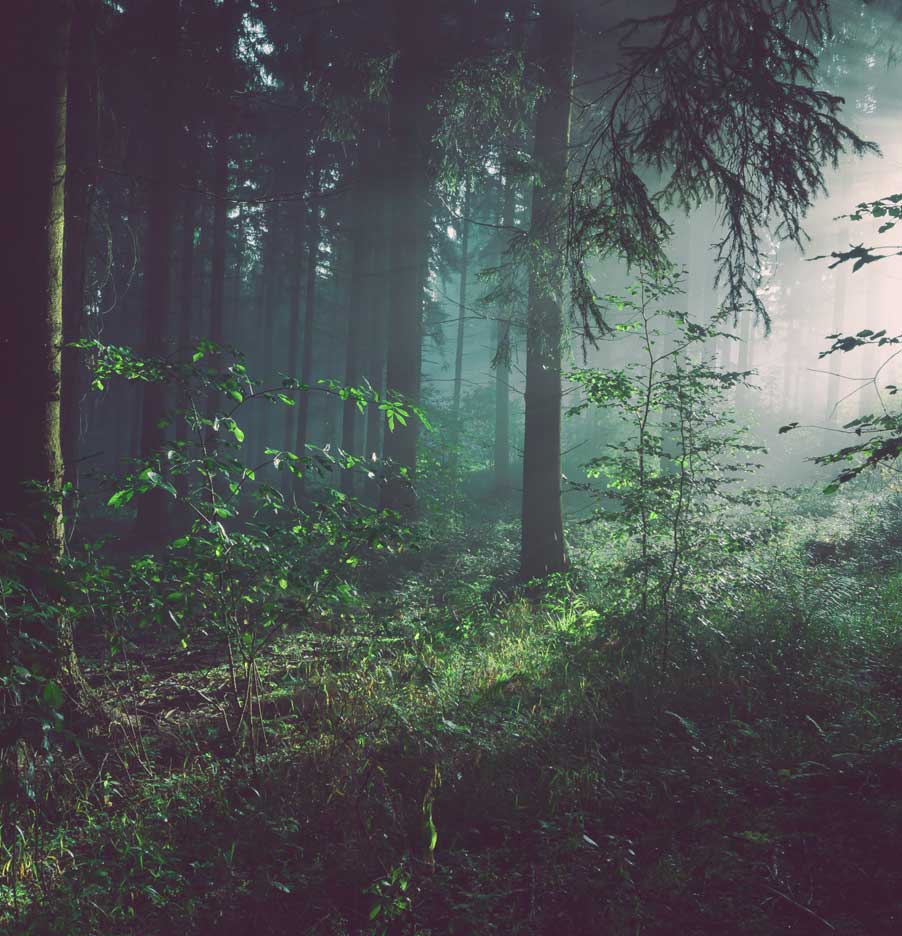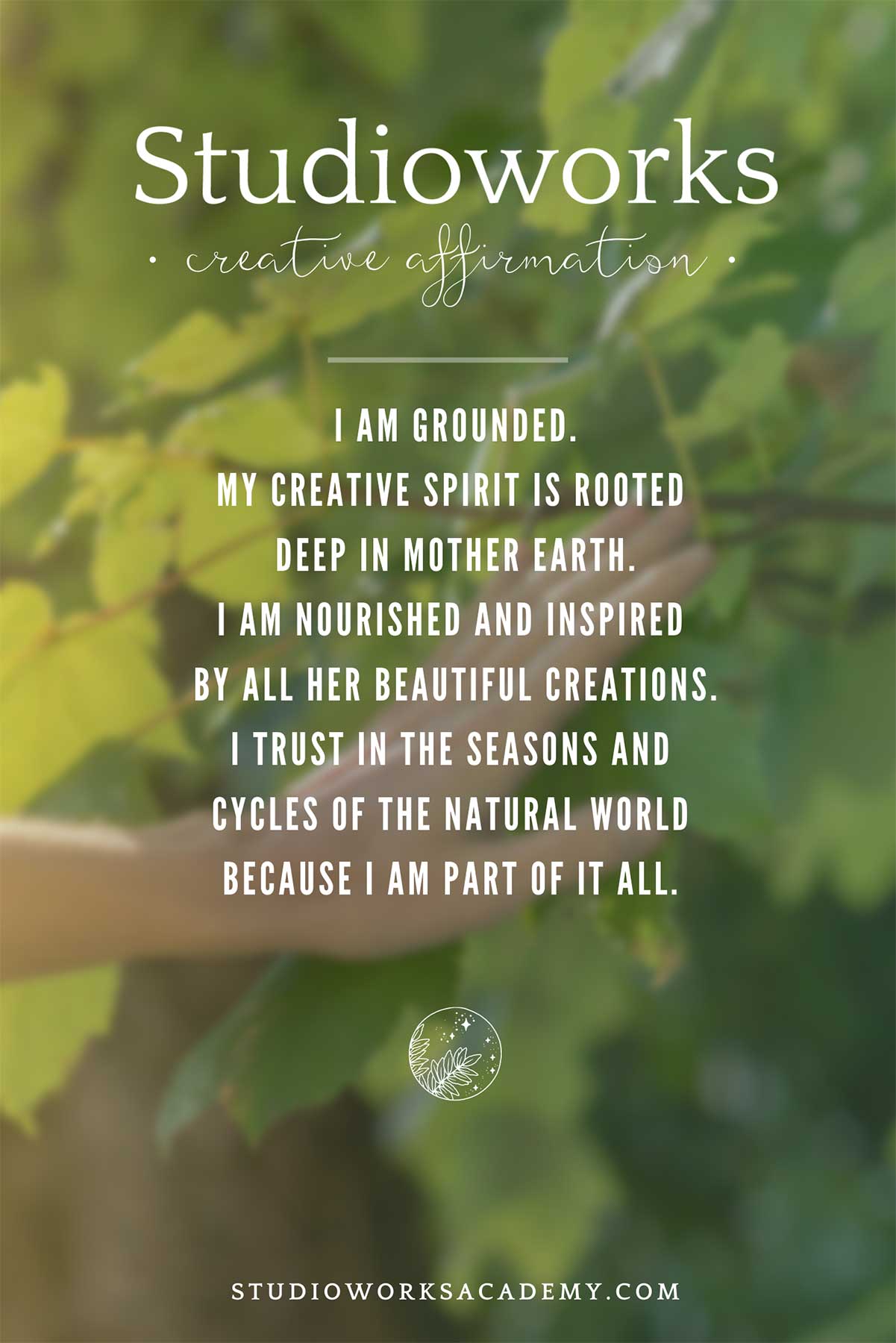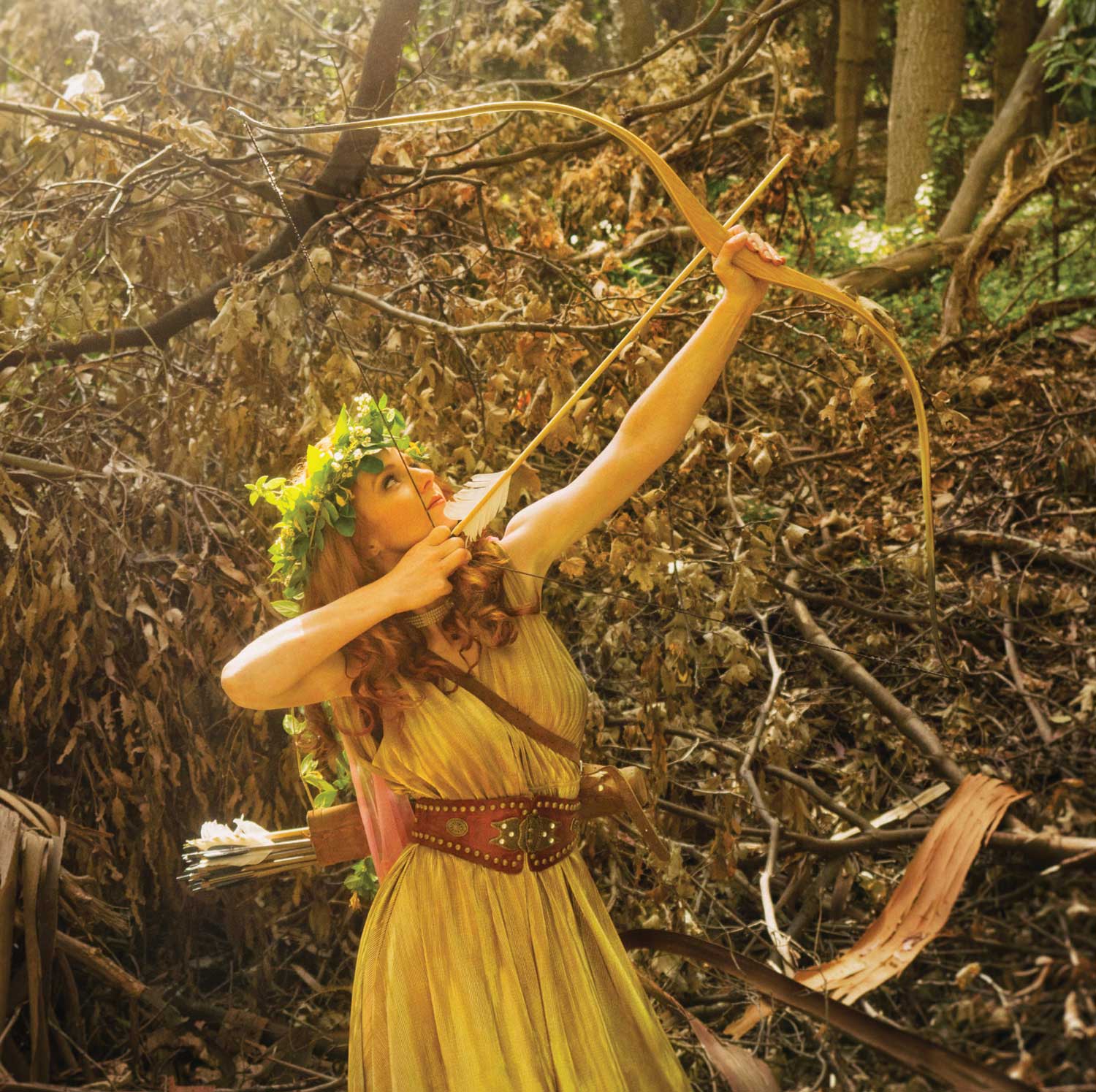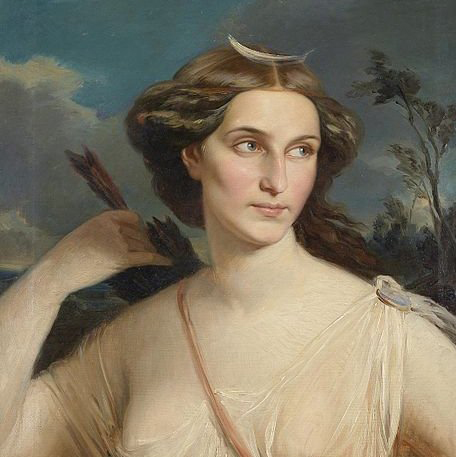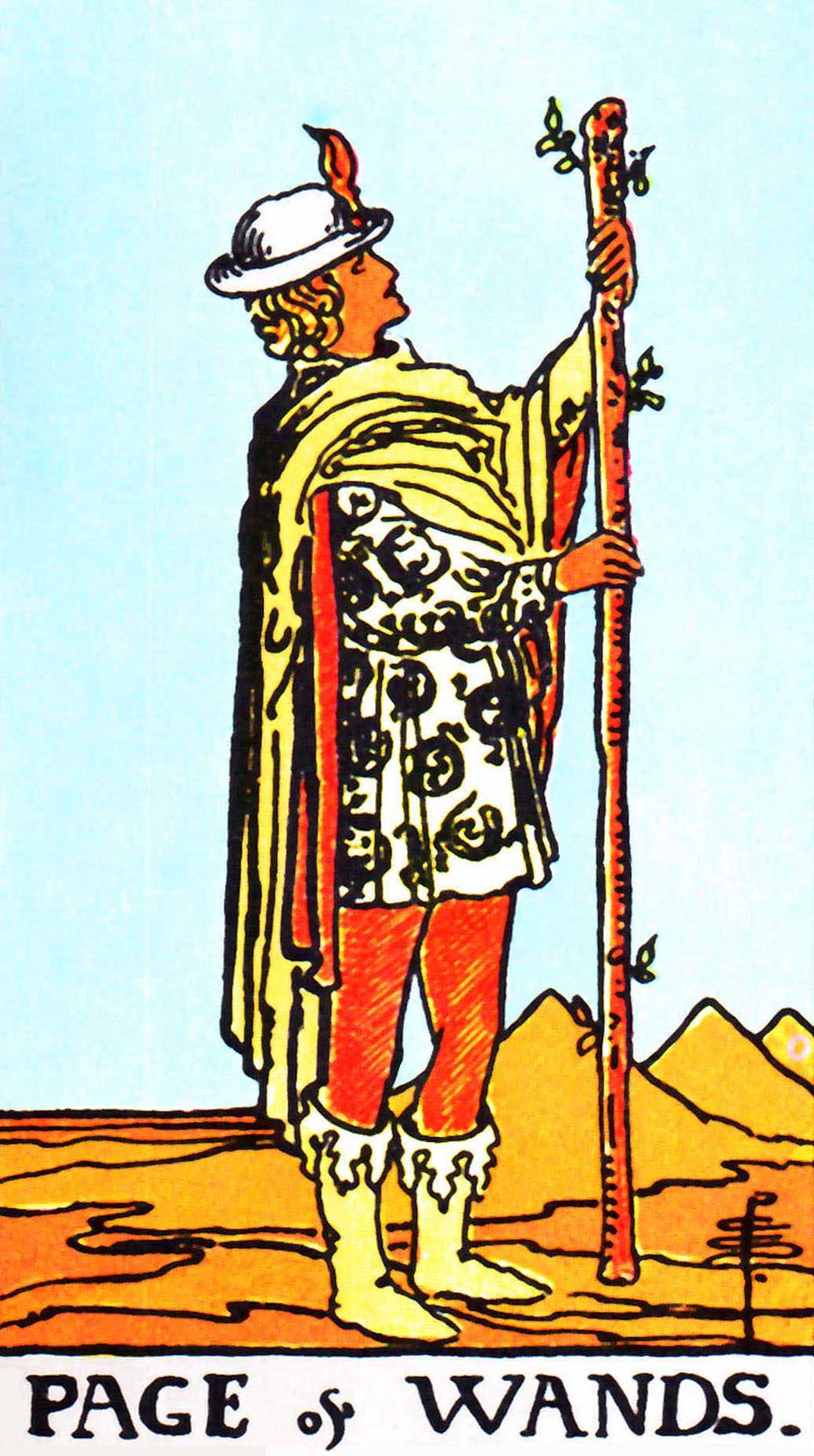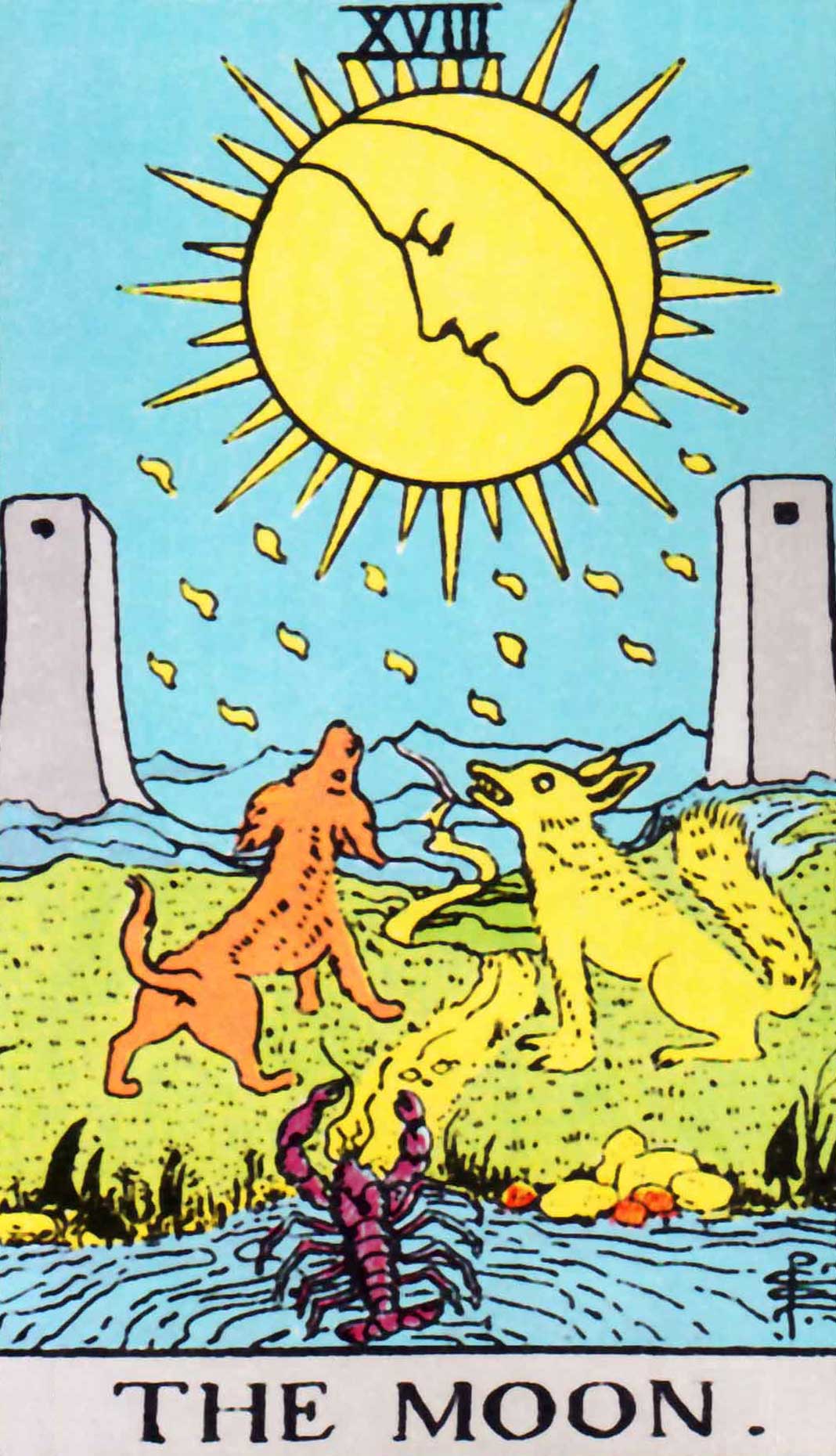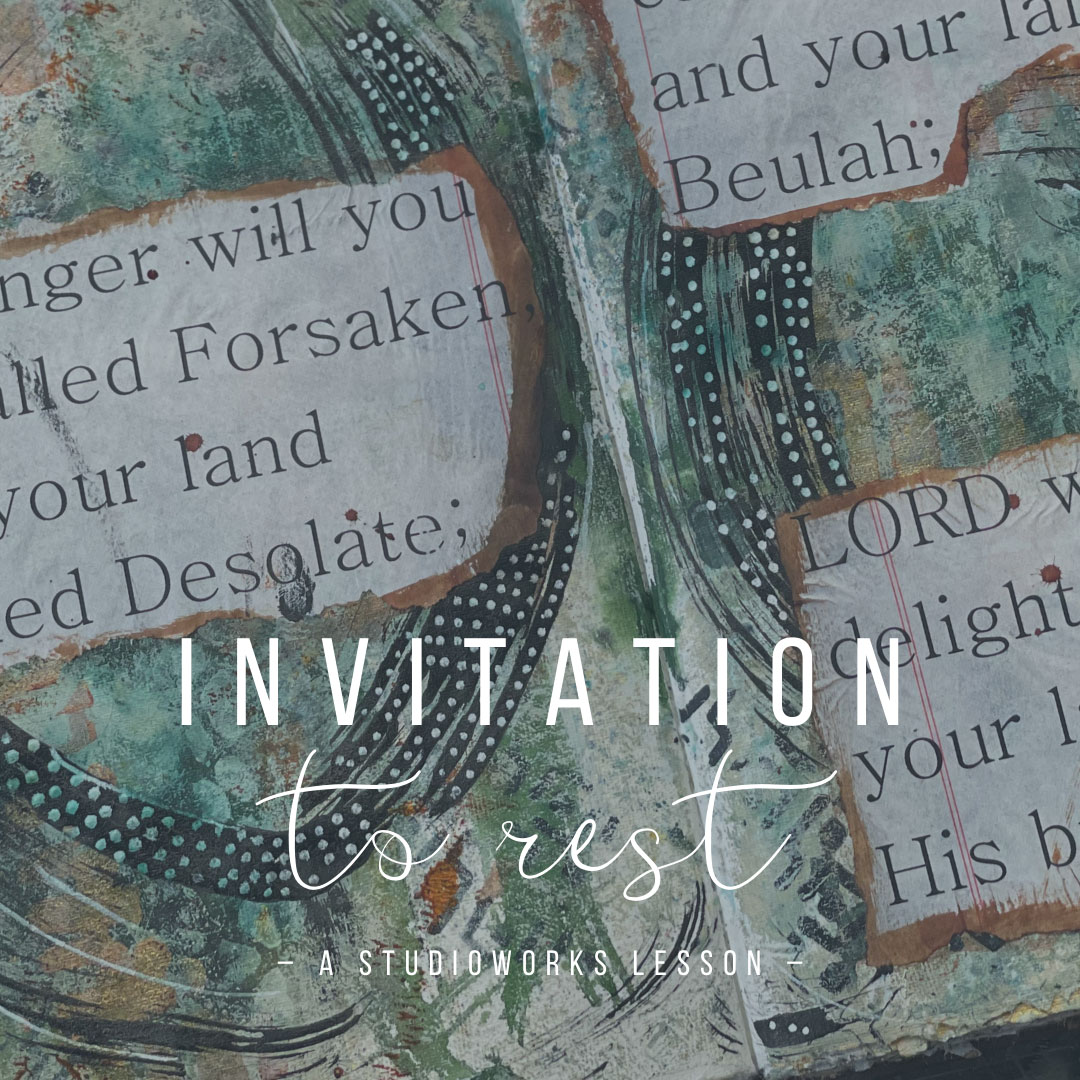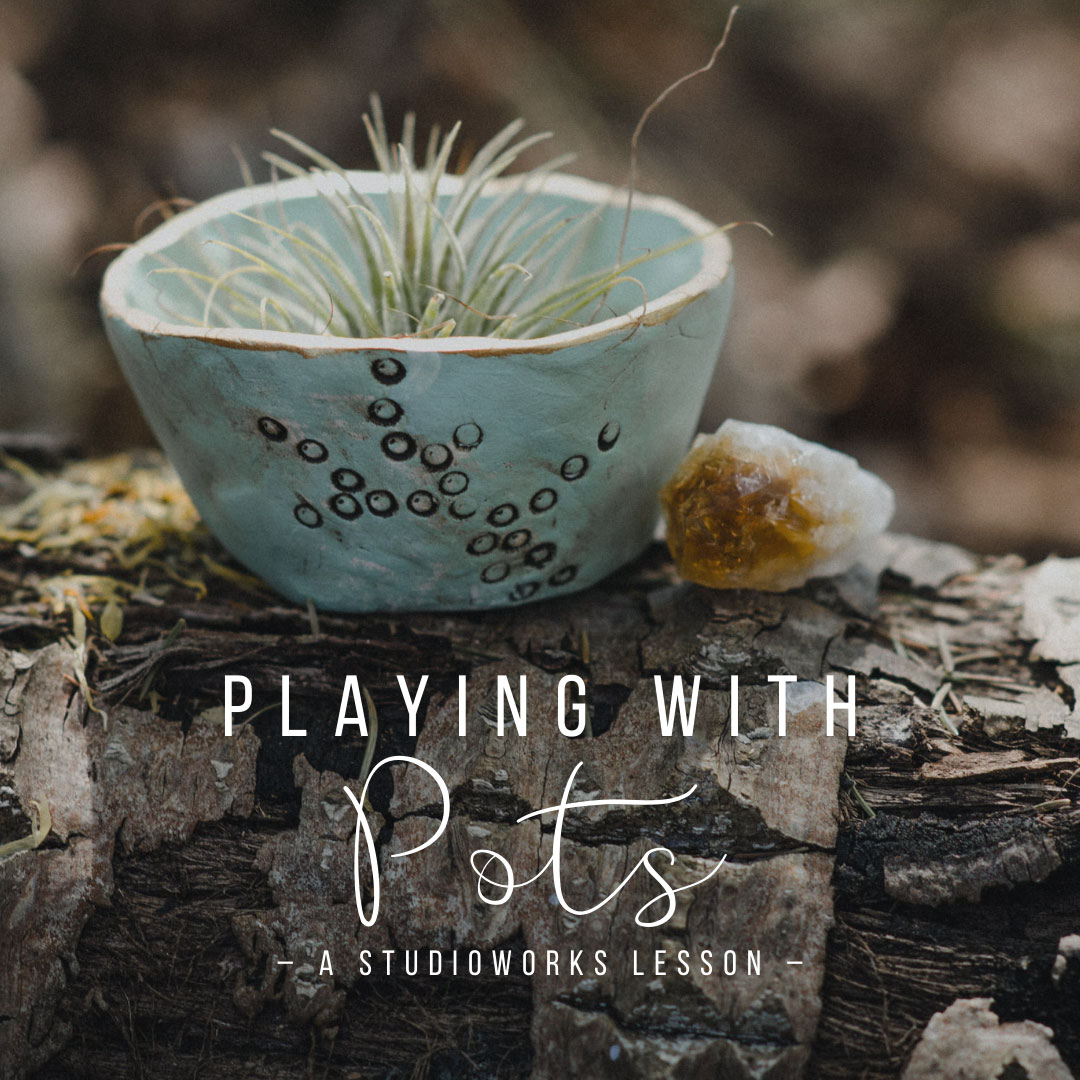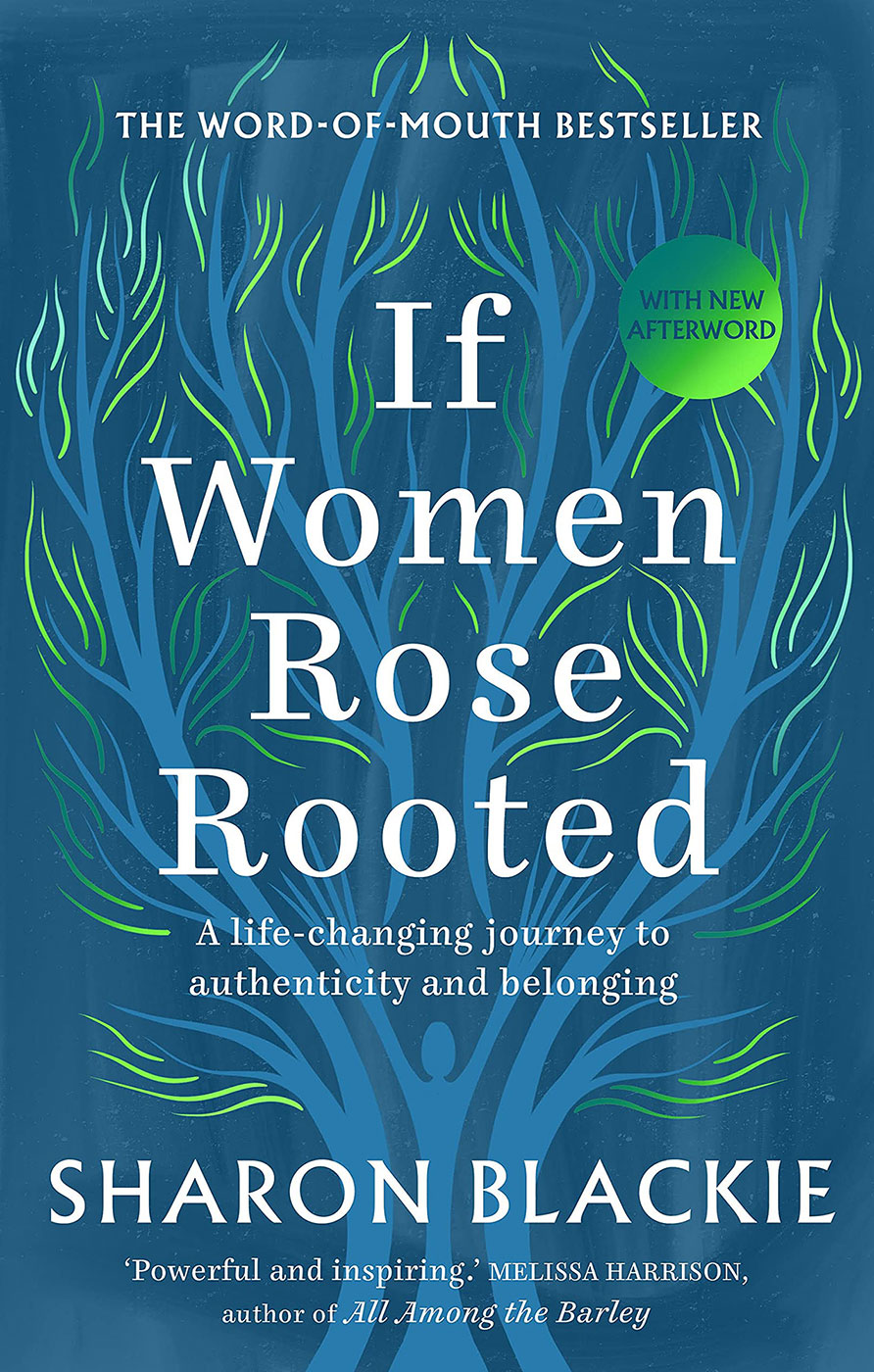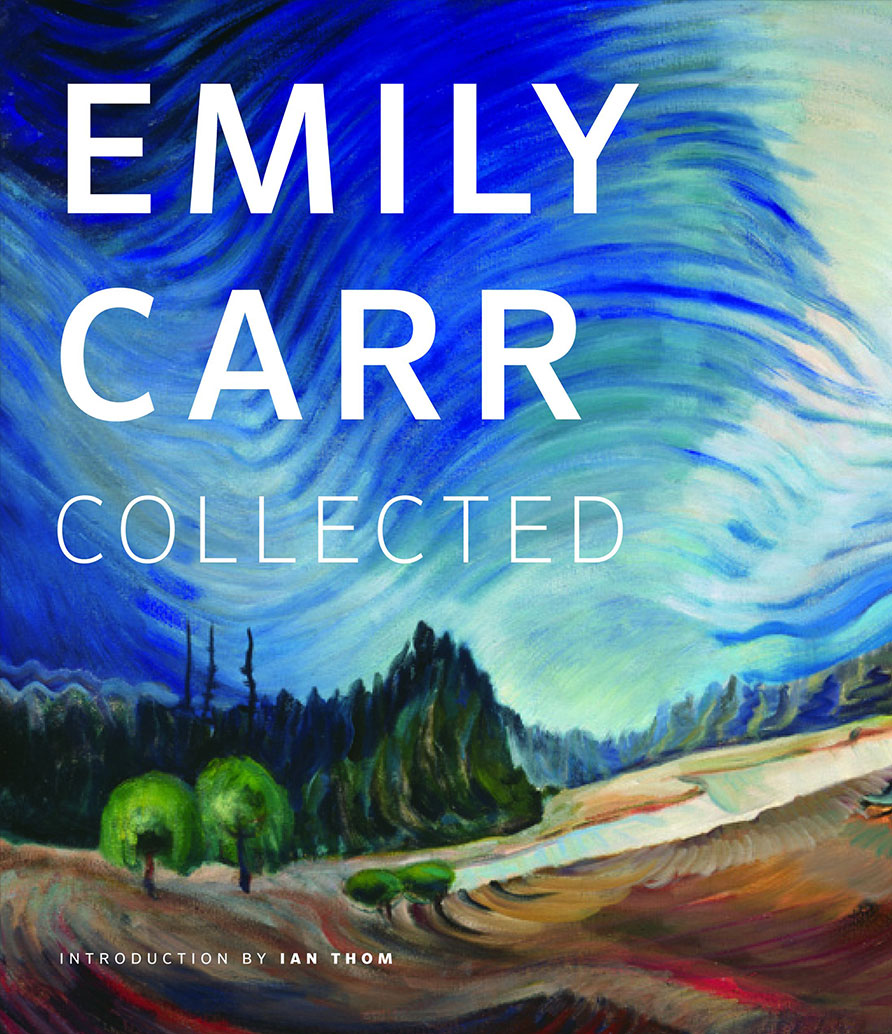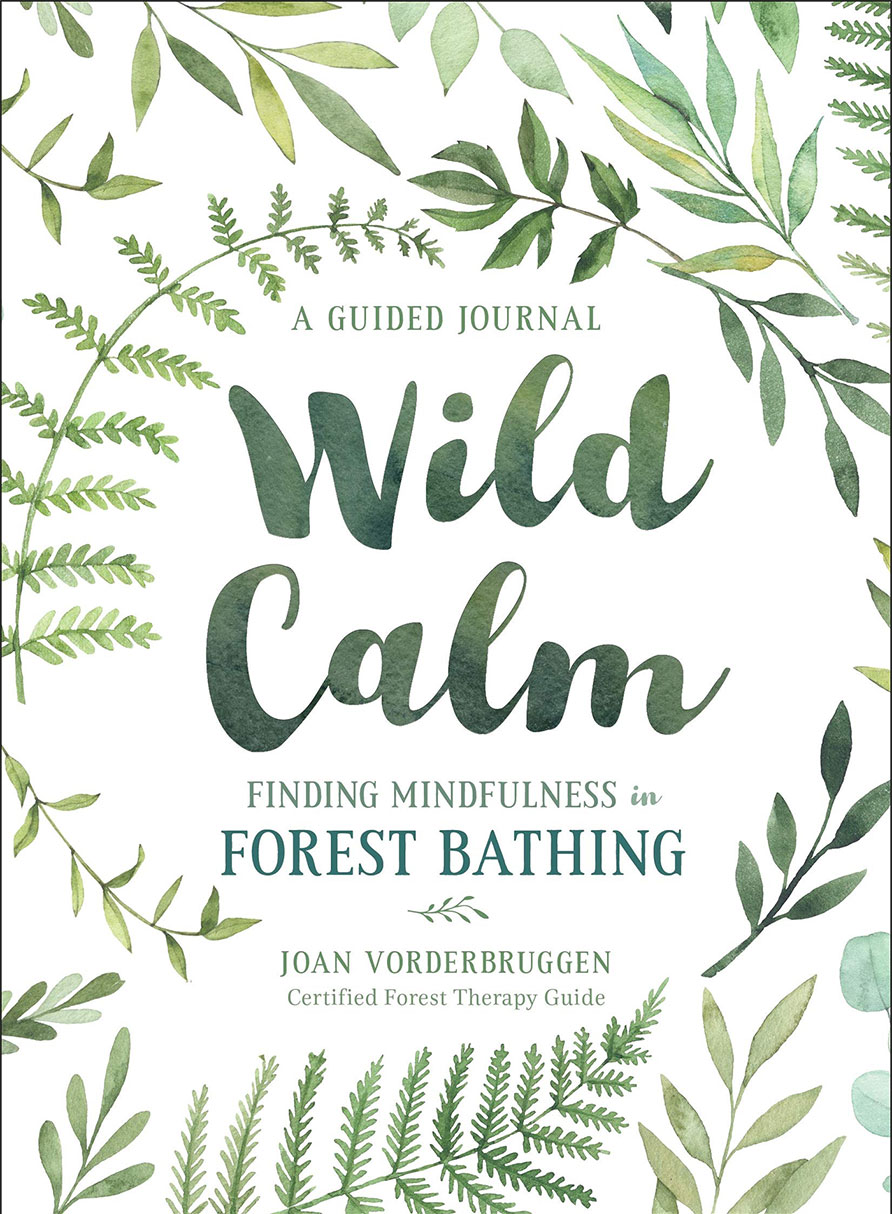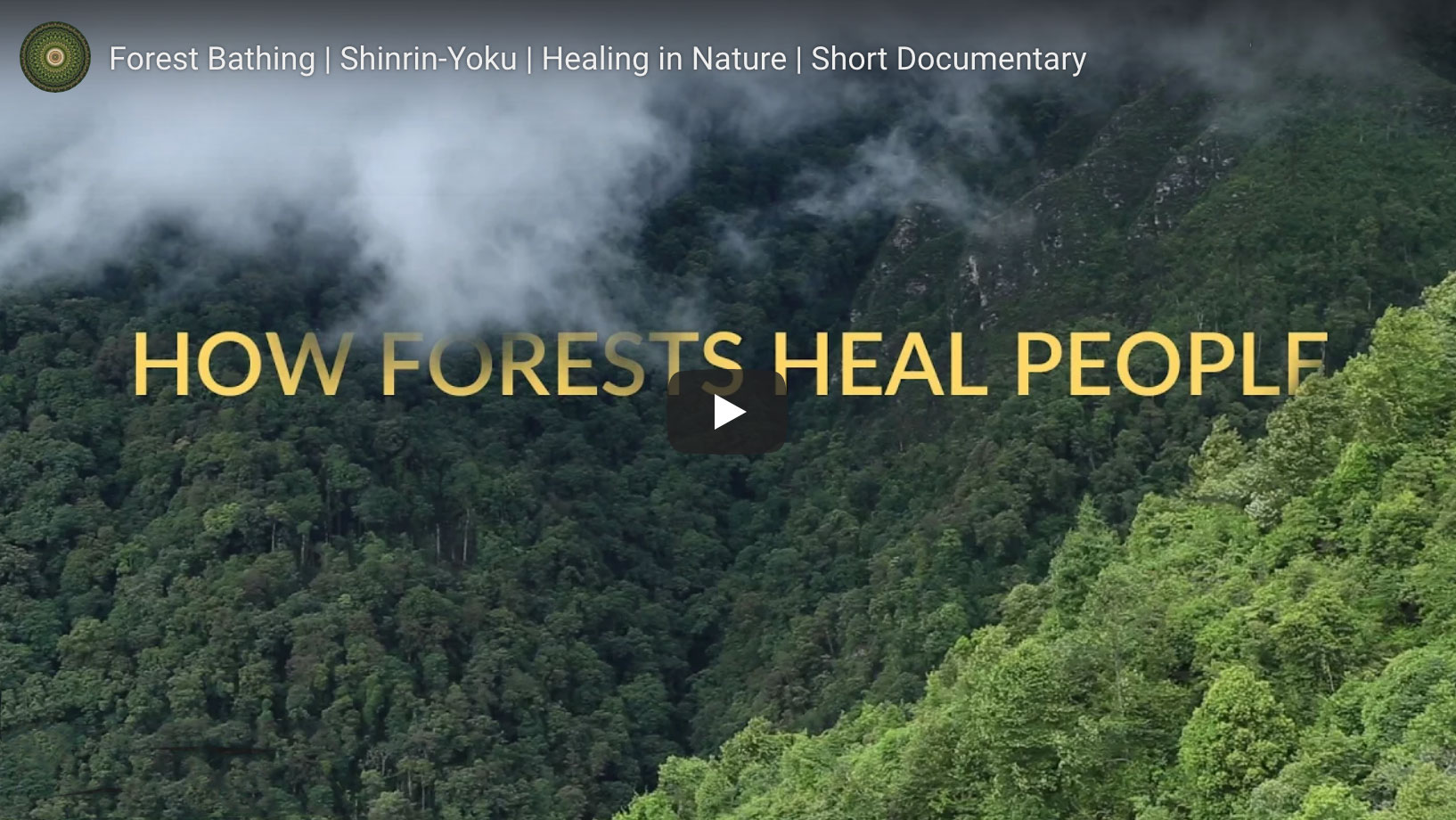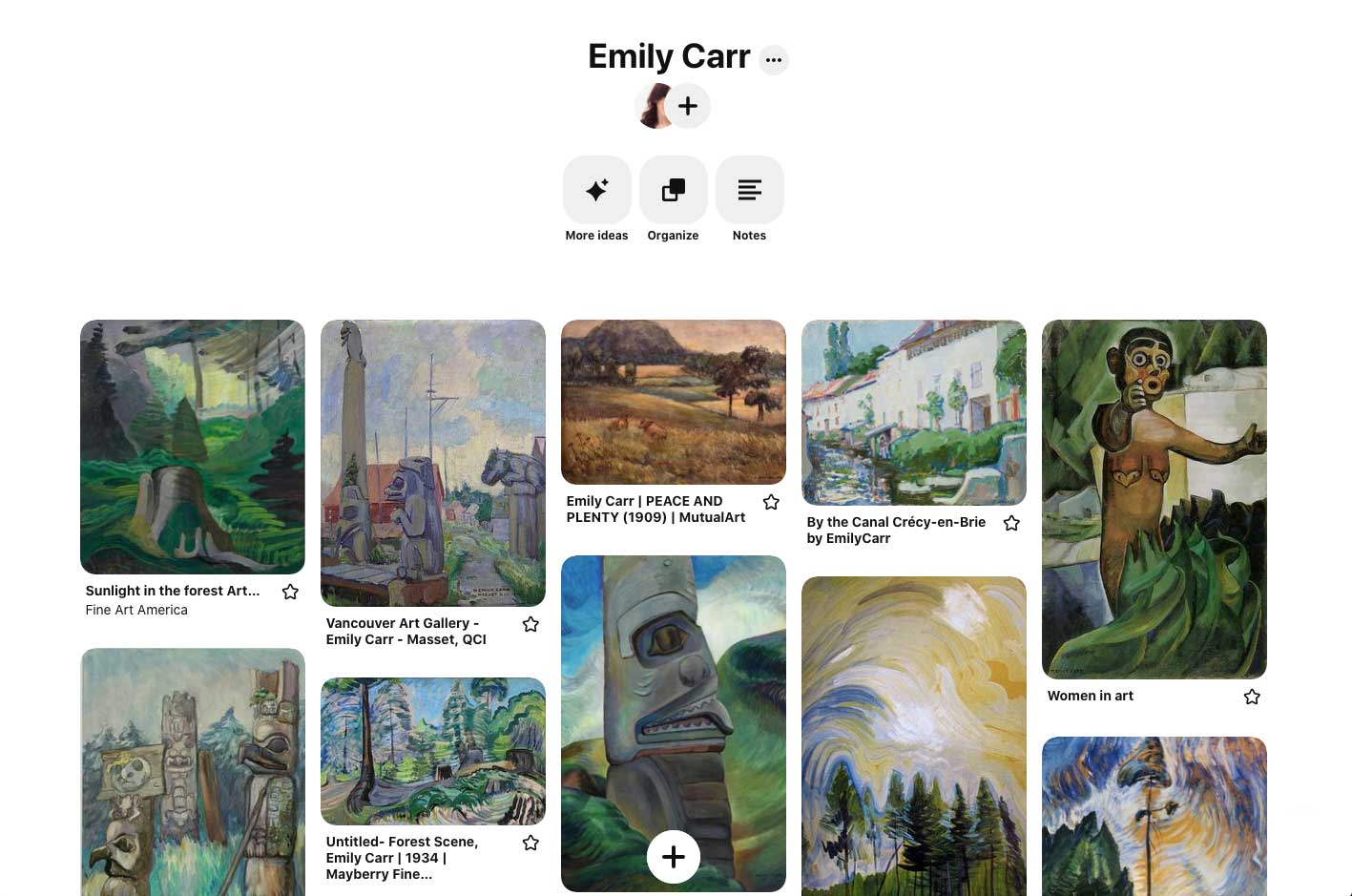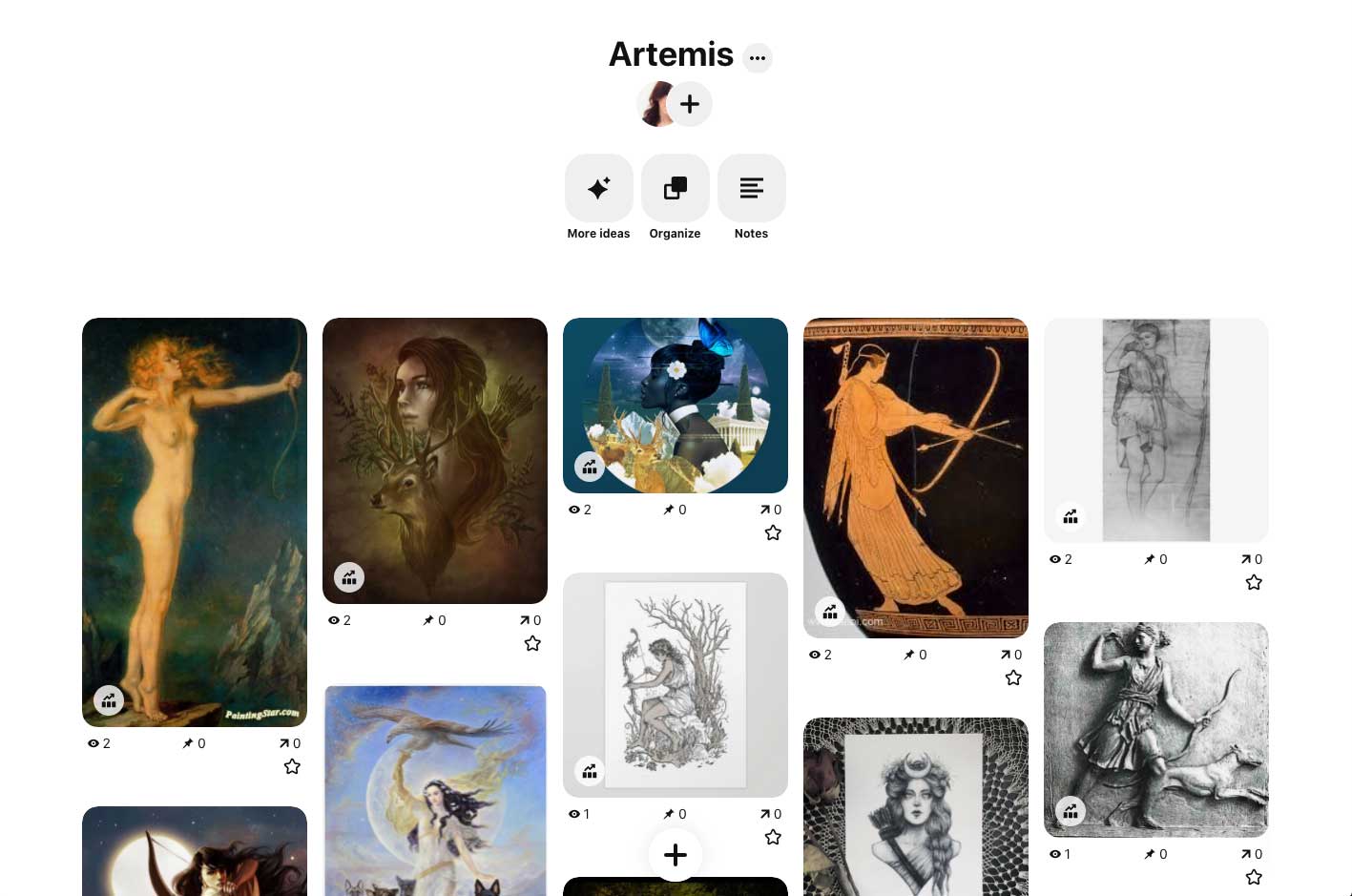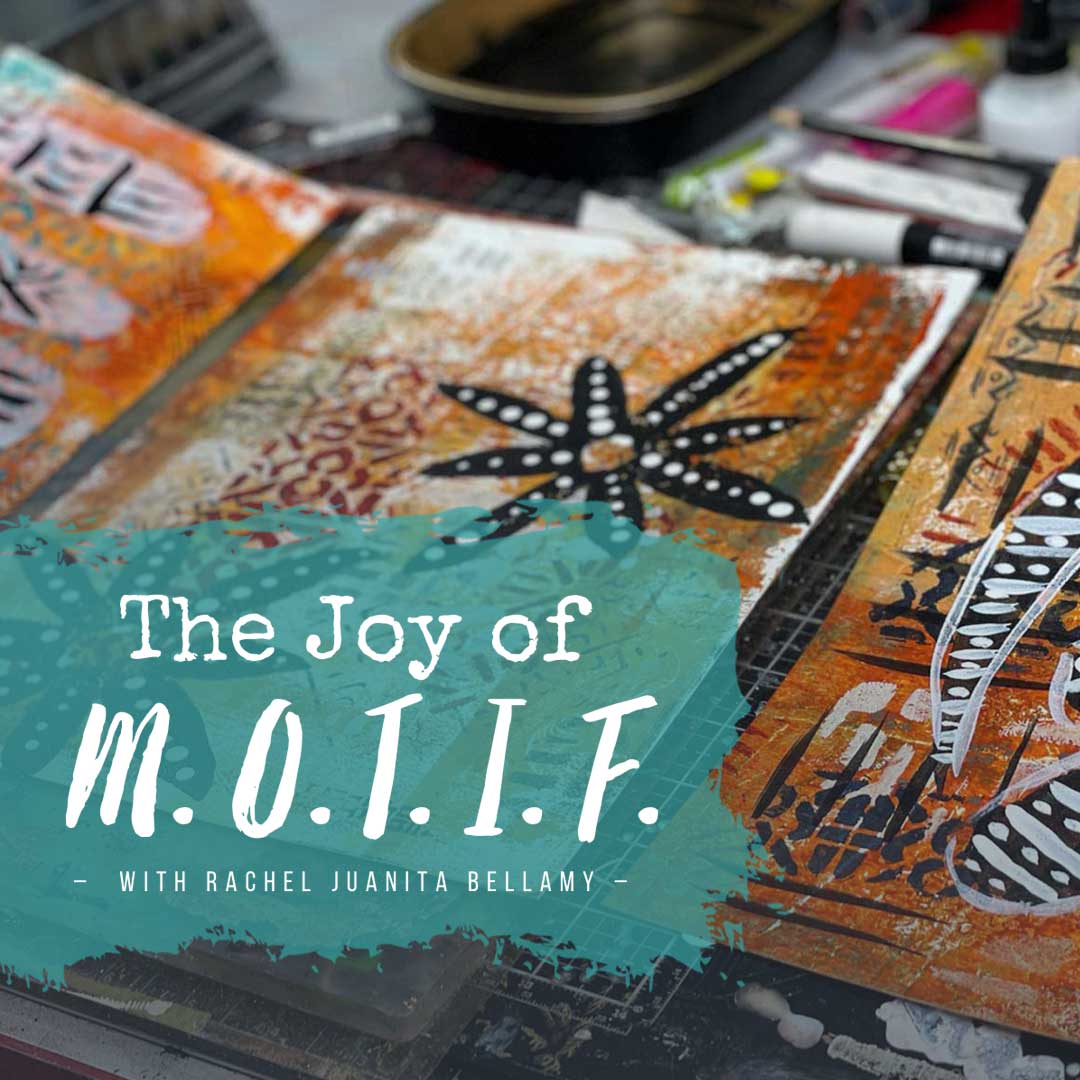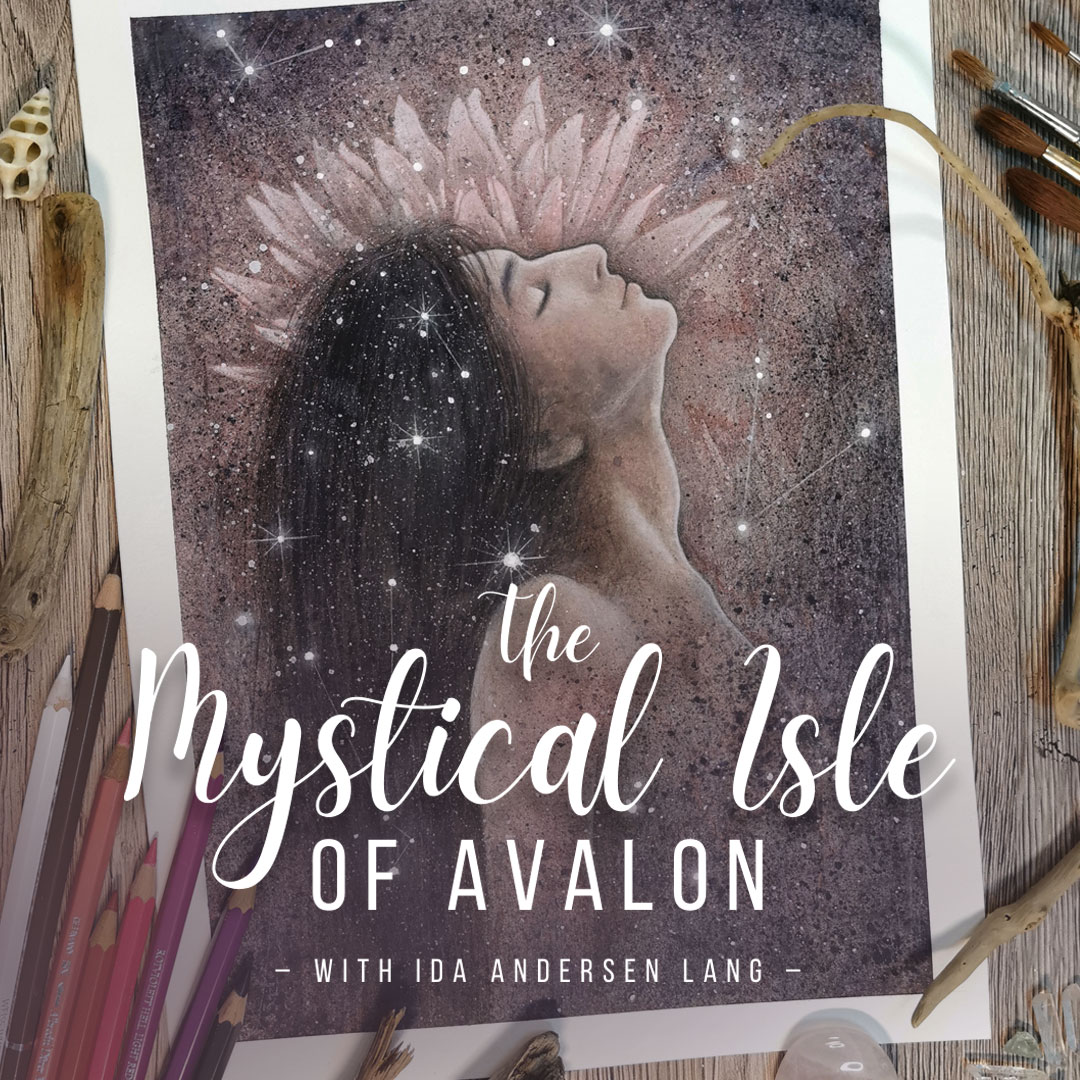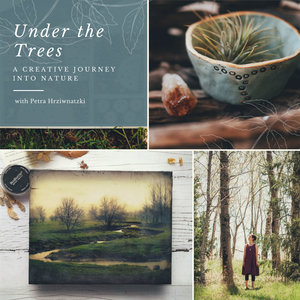IVY NEWPORT
Studioworks
Journal
a letter from ivy
Dear creative friends,
Welcome to Issue #32 of the Studioworks Journal! As always, I’m delighted you are here with me and I’m excited to share this with you. For the next few months we are going to be taking a journey through the Elements. Beginning with Earth, then Air, Water and finally Fire.
This direction occurred to me after some deep meditation and a desire to connect more intimately to our elemental creative energy. It’s so easy to forget that we are an integral part of the natural world. We are composed of these elements just as every thing on the planet is, so as artists and seekers, what better way to reconnect than to dive a little deeper into each of these aspects. We will still follow a similar format which includes studying a Master Artist each month, so fear not, we will definitely be binding our creative path to our explorations as always.
So let’s begin. Let us wander into the woods and discover messages the Earth has for our Artist’s soul…
xo,

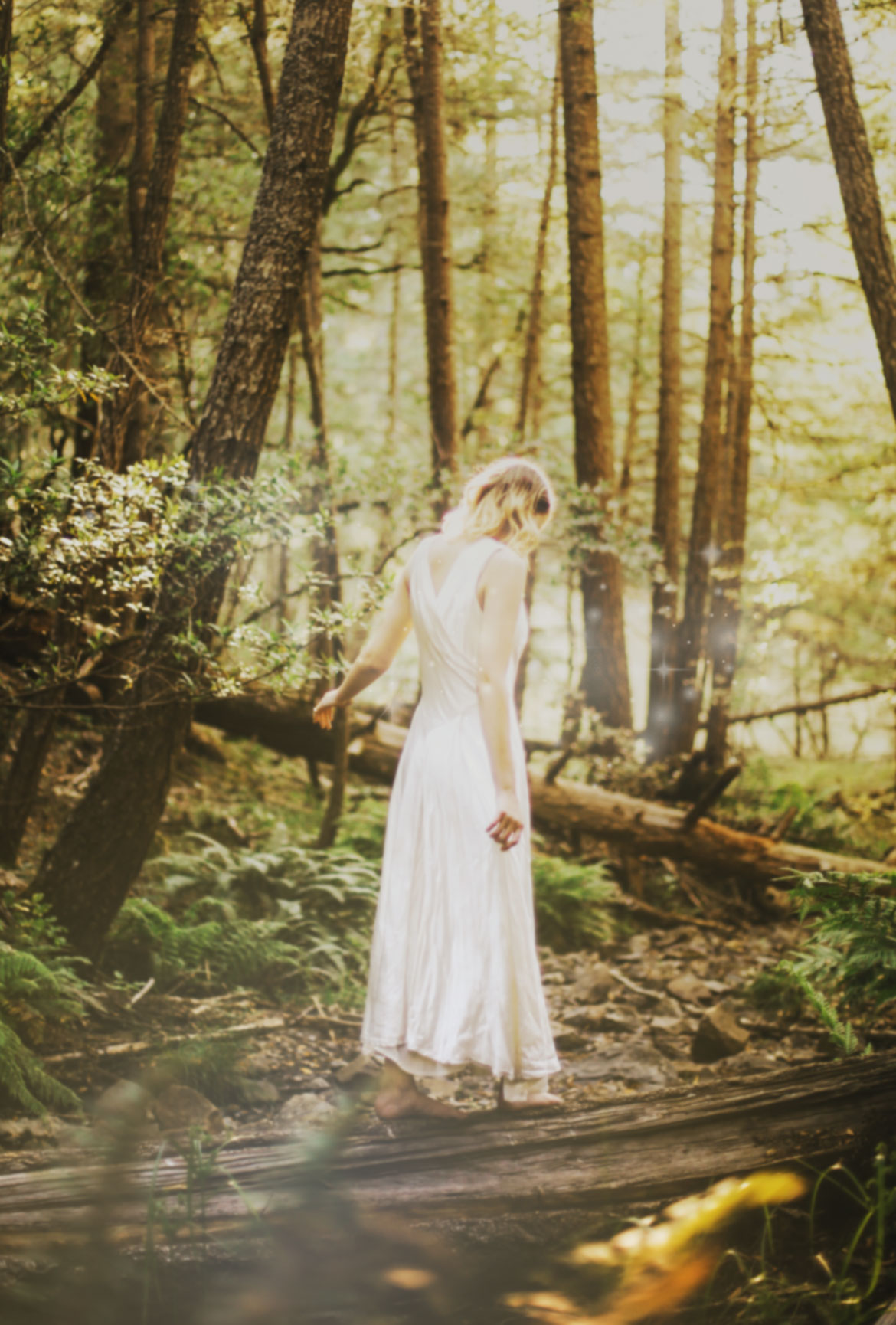
Each issue will invite you to explore your creative practice in whichever way works for you. Experience each issue at your own pace. Take what resonates with you and put the rest aside for another time.
Grab a cup of something lovely and dive in.
MONTHLY THEME
Forest Whispers
Around the world, over many centuries and across cultures, trees have been revered – worshipped, deemed holy – sacred and powerful. Today, we can find this same connection when we wander into the woods and gaze up at their grand heights. Pillars, reaching towards the heavens. Weathering wind, snow, drought, fire. Their roots reach into the earth for support and their boughs reach up to the divine, leaves unfurling in the light. These ancient masters have so much wisdom to share with us. If we listen, if we pay attention. If we stop, find stillness and listen to their whispers. As artists, we can learn so much from the trees. Take your sketchbooks out and sit beneath one of these majestic guides. I did just that and received such beautiful messages. Here are seven of these messages for the Artist’s journey.
“The earth’s a door, if you press your ear against it.”
– David Mitchell
7 Creative Lessons from the Forest
A tree naturally grows toward the light, it instinctively knows that this is where sustenance can be found. Where its growth and life can be supported.1. Find Stillness
The Artist must find ways to cultivate stillness. It is only when we still our minds and bodies can we hear the soul speak. We so often resist this kind of quiet but it is quite necessary to the creative process. An imaginative mind is a busy mind, swirling with ideas and colors and concepts and yes, all of that is wonderful but our souls have something to say too. This voice is often so much softer than our conscious thoughts but it’s message is pure and not laced with ego or expectation. So, as the trees do – stay still, breathe, let the sun shine on your face, let the wind blow around you, let your toes dig into the earth and then (and this is the important part) listen. Be grateful you are here. Be planted. Be rooted. Find moments to just BE.
2. Reach toward the light
A tree naturally grows toward the light, it instinctively knows that this is where sustenance can be found. Where its growth and life can be supported. We must do the same. Do not gravitate towards negativity, darkness or doubt. These things will not support your creative path. Reach, however gently, towards what you love. To the things, people, energy that can help sustain you. That brings you joy. If you find yourself reaching towards the shadows ask yourself why? While there are lessons for us to learn in the shadows, we are not destined to stay there. Be conscious of where you are putting your energy and who you are investing your time in. Honor yourself and your creative path by always returning to the light. You deserve this. Just like the trees, you need the light to thrive.
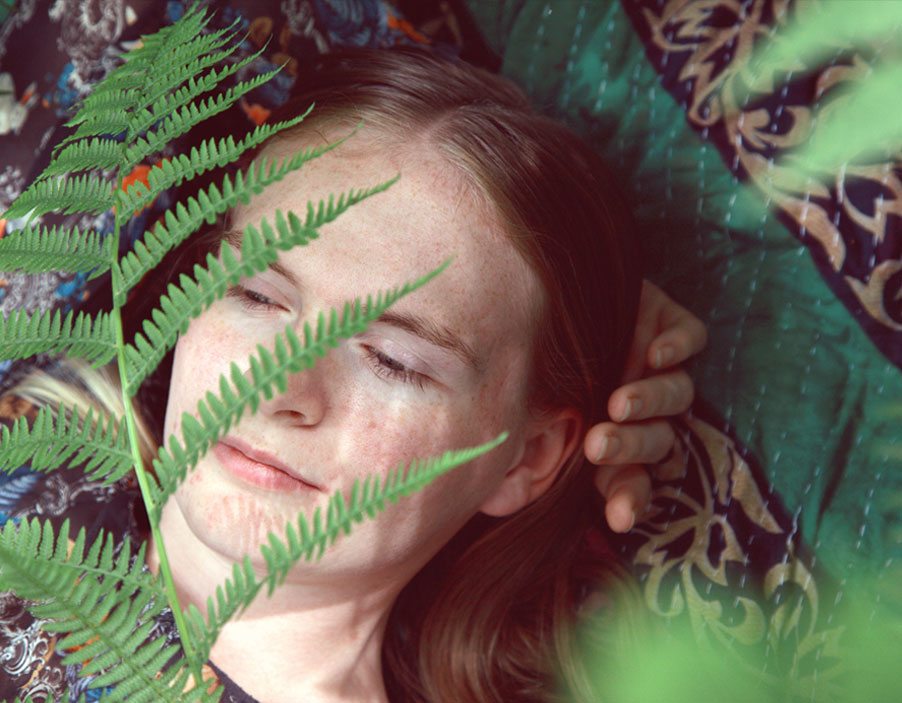
3. Trust the Seasons
A tree does not question when it is time to bloom in the Springtime, nor does it hesitate to drop it’s leaves in the Fall. We must trust that our creative lives are made up of similar cycles. Resist the temptation to clutch or grasp. Instead trust. When your creative energy recedes after a big project, don’t be fearful. Trust that the time has now come to rest. When a style no longer suits you, don’t hold on to it. Let it fall away so something new can emerge. It sounds so simple but as humans, we don’t naturally do this. We try to control everything. This only gets in the way of our natural, divine cycles. All we need to do is look at nature to be reassured that absolutely everything is cyclic. Including you. So trust in that.
4. Put your roots down deep.
A tree’s roots are an extraordinary, underground network that provides support, nutrients and foundation. Without its roots a tree topples over. We Artists are similar – if you are constantly looking outward, comparing yourself, changing yourself or condemning yourself, your roots will fail. They are too close to the surface, they are too dependent on the world outside yourself. We must send our roots deep and be grounded in who we are, regardless of anyone else. We must remember that we arrived on this planet perfectly and no one can take that from us. Our roots give us strength, confidence and presence. So let them go way down. Tether yourself to Mama Earth’s core and stand tall and strong in your creative expressions. Remember the truth of who you are.
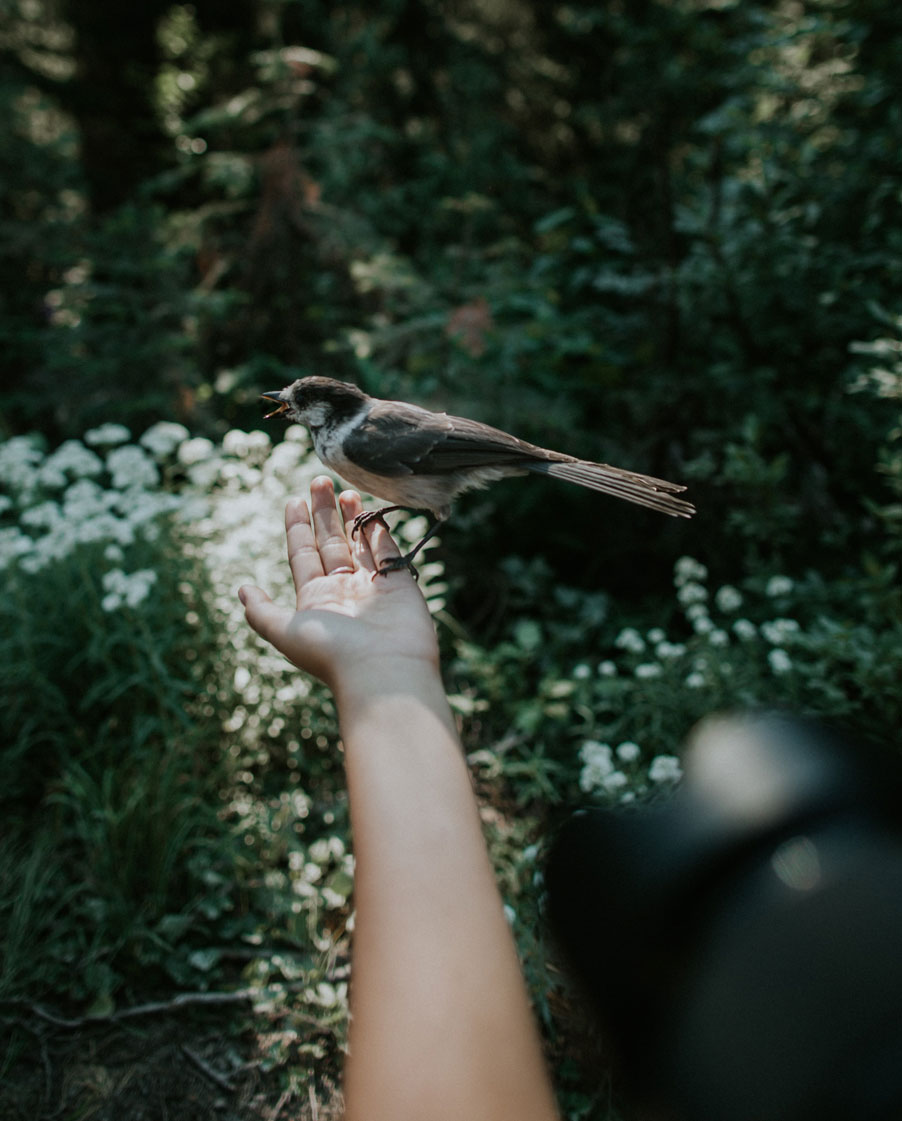
“Our place on Earth is to go deeper, to somehow get wiser. To have spirit.”
– Glen Hansard
5. Connect to your community.
Did you know that trees actually communicate with each other? They do! Through a complex system these amazing sentient beings can warn and nurture each other. We creatives must do the same. While we might need our solitude, we also yearn for community. So send those roots out and find your creative friends, be it online or in person. Then once in community, stand by your artist friends. Support each other. Have each other’s back. Share ideas and expertise without withholding. Give freely to one another. A creative community is symbiotic. Each member can help nourish another and in turn another. Do not be jealous. Celebrate and connect and rejoice in your creative journey. Reach out without judgement and you will find soul sisters and comrades on this path. Artists often beat to a different drum but when we come together it is a symphony of passion and creative freedom.
6. Revel in your Uniqueness
In a forest, you may look upon hundreds of towering pine trees BUT not one is actually alike. Each tree has its own shape, each grows at a slightly different rate. Each root system will have a unique pattern. Each tree’s branches reach toward the light in slightly different angles and directions. You, dear Artist are the same. You are beautifully, incredibly unique and that’s exactly what you are meant to be. Your creative path won’t look like anyone else’s, nor is it supposed to. Your art may reflect your influences but ultimately it won’t be the same as anyone else’s art. Your hand interacts with your materials uniquely and the marks you make are your own. Revel in this and rejoice in being an extraordinary, completely unique individual.
7. Never stop growing
Trees may stop growing in height at a certain age but they continue to add width to their trunks and also sprout new branches and leaves. We must do the same. You are never at the end of your creative growth. There is ALWAYS something to learn, something to explore, something to refine. If you find yourself an “expert” in one area of your work, where could you expand next? What could you try to do differently? As we evolve, so does our art. Allow that growth to occur, embrace and encourage it. Keep your mind and heart open to seeing the world anew over and over again. Bring this wonder to your work and never stop growing.
“Whoever has learned how to listen to trees no longer wants to be a tree. He wants to be nothing except what he is. That is home. That is happiness.”
– Herman Hesse
Forest Whispers: 7 Creative Lessons from the Forest
I love this poem by Mary Oliver. The first time I read it my eyes pricked with tears. There is such reverence and tenderness in these sacred words. A deep and loving prayer to the forest. A holy regard for all that it offers to our weary human hearts. Enjoy.
Sleeping In The Forest
I thought the earth remembered me, she
took me back so tenderly, arranging
her dark skirts, her pockets
full of lichens and seeds. I slept
as never before, a stone
on the riverbed, nothing
between me and the white fire of the stars
but my thoughts, and they floated
light as moths among the branches
of the perfect trees. All night
I heard the small kingdoms breathing
around me, the insects, and the birds
who do their work in the darkness. All night
I rose and fell, as if in water, grappling
with a luminous doom. By morning
I had vanished at least a dozen times
into something better.
– Mary Oliver
Sleeping In The Forest
CREATIVE INTUITION
with Elizabeth Cooper
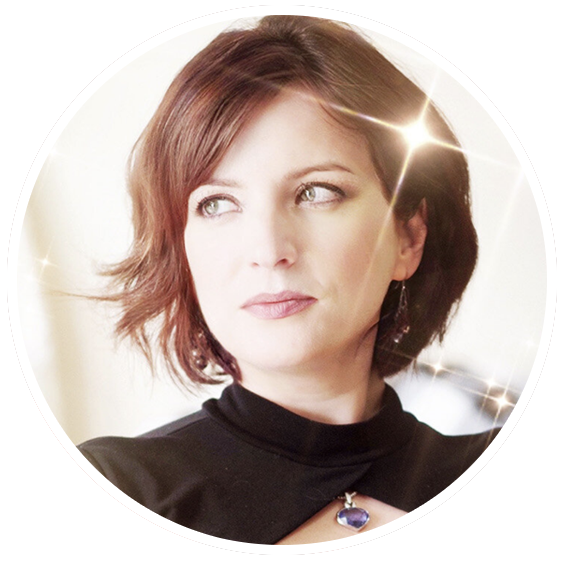
I’m excited to announce that my dear friend and fellow artist will be a regular contributor to the Studioworks Journal! She is my go-to when learning more about my intuition and integrating it into my creative practice. This month she’s going to guide us through the Earth’s suit of the Tarot – The Pentacles. Enjoy as she reveals the symbols, stories and significance of this powerful suit.
The Earth Element in Tarot: An Artist’s Guide
“From wealth and prosperity to personal responsibility, tapping into the element of the earth can imbue your spiritual art practice with a rich sense of practical abundance.”
Tarot cards are full of incredible symbolism. Each one of the 78 cards holds enough inspiration to see you through a lifetime of creative pursuits. But that same wondrous complexity also makes learning tarot feel overwhelming, especially if you’re just picking up a deck for the first time.
I’ve found that one of the easiest ways to learn to interpret the cards is to familiarize yourself with the role the elements play in the tarot’s structural foundation. Each of the four elements imbues a specific suit with its energy, allowing that element’s themes to resonate deeply through each upturned card.
This month, we’re starting with an in-depth look at the element of earth.
As you’ve seen throughout this entire issue of Studioworks, the element of earth is what connects us to Mother Nature. It’s the way we ground ourselves on firm, reliable, strong footing. Moreover, it’s where we plant our seeds and nurture them, so they grow into the things that sustain us.
Symbolically, the element of earth also represents our wealth and prosperity. It’s the embodiment of all material things: from the homes we live in (traditionally built from wood and/or clay) to the food we eat.
Earth is tactile, moldable, yielding… and yet so very strong. It’s tangible and fertile. It holds a feminine essence that makes it both receptive and creative. Through the earth, the nutrients and sunshine coalesce into the remarkable ability to produce and sustain life.
Earth is both root and origin. Receiver and creator. Stability and transformation.
The Earth in Tarot
Given all the characteristics of the element of earth, it should come as no surprise that it’s deeply connected to the suit of pentacles, which depicts the physical experience of being human.
When looking at a pentacles card, think about the way the earth is represented within the imagery. Typically, the cards that make up the suit of pentacles tap into our innate sense of human resilience, personal responsibility, and reliability.
Think about the resources you have at hand, the ones you use to create your life and your art. Tap into your body, your finances, and your personal sense of safety and security. All of those aspects are richly depicted in the suit of pentacles.
The suit of pentacles is also closely associated with work, business and financial prosperity. If you’re actively working on turning your passion for art into a business, you’ll want to pay close attention every time the suit of pentacles turns up in your spiritual practice. When you’re truly connected to the symbolism of the pentacles, you’ll notice an increase in your ability to manifest your tangible dreams.
The significance of earth energy can be felt in our outer surroundings. And because pentacles deal with the physical, they mirror the circumstances of our world. These cards allow us to explore how we create, mold, shape, transform, and grow the various external aspects of our lives.
Earth Elemental Correspondences
- Suit: Pentacles (aka: coins, disks, stones, diamonds).
- Court cards: Pages (aka: princesses, knaves, heralds).
- Major arcana: The Empress, The Hierophant, The Hermit,
- The Devil, The Universe,
- Astrological signs: Taurus, Virgo, Capricorn.
- Attributes: Female, passive.
- Direction: North.
- Season: Winter.
- Sense: Touch.
- Statement: “I am…”
- Colors: Brown, green.
The Artist as an Earth Elemental
For your artist self, the element of earth represents every material object you need to make your art (paint, canvas, paintbrush, etc.). It also reflects your physical body and any other tangible item you need to transform your idea into an actual object.
Knowing this, I’d like to invite you to go a little deeper into your elemental nature.
Imagine the many ways you, as an artist, embody the aspects of the element of earth. Ask yourself questions such as:
- Am I practical and grounded in my approach to making art?
- Am I focused on turning my passion for art into a career?
- Am I resilient in my art practice?
- Am I generous to myself and others?
- Do I relish the sensual, tactile aspects of art-making?
- Do I enjoy using my hands and getting them dirty while I make art?
If the answer to most of those questions is ‘yes,’ then I encourage you to lean into your earthen nature.
Connecting to the Element
The best way to connect to an element is to observe it in its natural form. Here are just a few ideas to help you get in touch with the essence of earth:
- Go on a hike.
- Lie down in your backyard, taking note of the way your body feels as it’s being supported by the unyielding ground.
- Have a picnic at a local park.
- Scoop up a handful of raw earth and let it fall through your fingers.
- Smell the dirt after torrential rainfall.
- Check out the worms wriggling on the wet pavement.
- Hug a tree and ask it a question, then write down the first answer that occurs to you.
- Imagine you are that tree. Visualize your own roots going deep underground, helping you be steady and resilient.
When you get home, pull out all the suits of pentacles cards in your deck and lay them out in front of you. Then, take note of the earth symbolism in each card.
What do you notice now? Are the trees in bloom or devoid of leaves? Is the ground barren or awash in new growth? What color are the flowers? How will you interpret material wealth through the lens of earthen abundance?
Make a note of any new insights. Your understanding of both the suit of pentacles and the element of earth will expand as you open yourself to the spiritual guidance you receive through your art practice.
I’ll see you back here next month as we explore another element.
“We are on the Earth to… wrap our consciousness around the divine treasure within us…”
– Dr. Michael Beckwith
Earth Artist PROMPT:
- Get out in nature and sketch the beauty you see. It’s not about how “good” your sketch is, it is in witnessing and worshiping the world around you that will nourish your soul.
WORD OF THE MONTH
Grounded
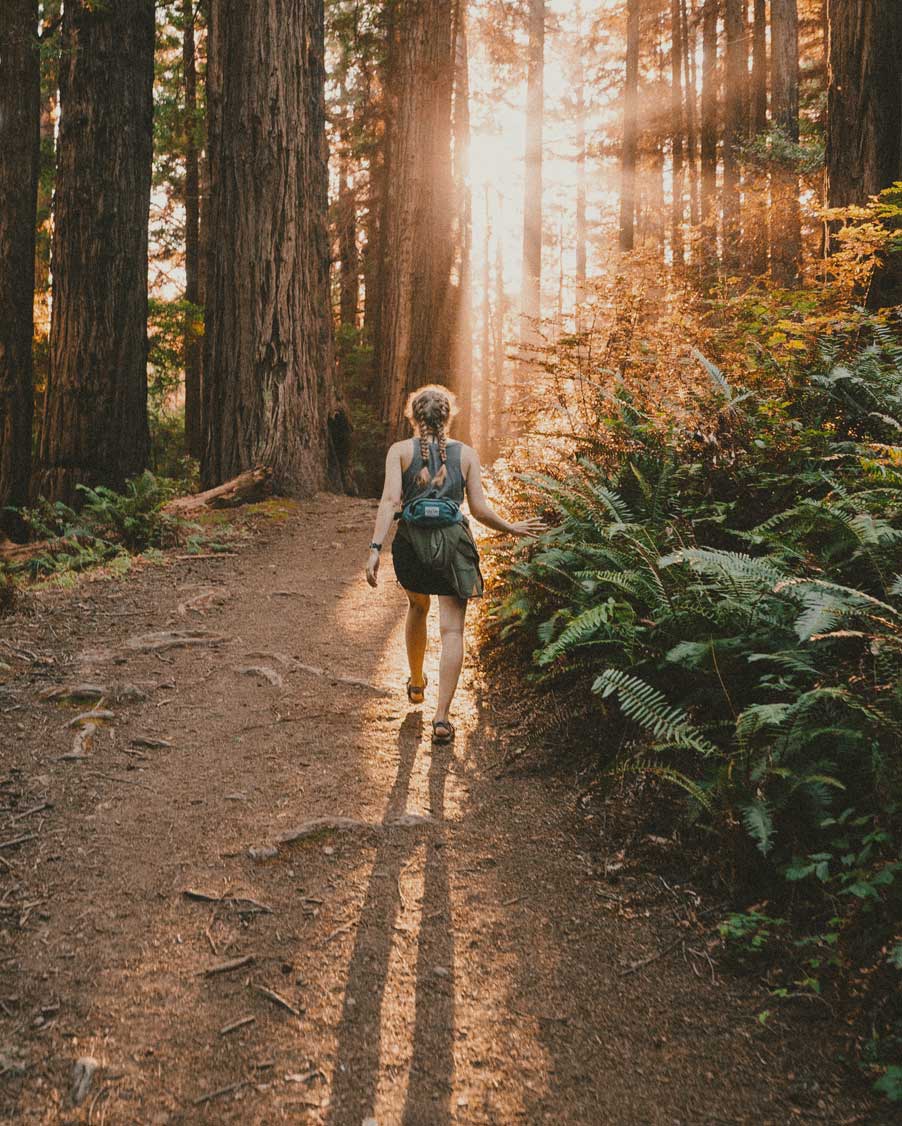
DEFINITION – GROUNDED
adjective – mentally and emotionally stable : admirably sensible, realistic, and unpretentious.
Earth energy reminds us to stay grounded in our artistic life. To stay humble. To find strength and rootedness in who we are. Earth energy encourages us to find our core and connection to the natural world. Mother Earth offers her support and sustenance. Be held by this energy. Earth wants us to move our bodies, to dance, to feel things deeply, to explore and wander and be filled with wonder. She wants us to create beauty along with her. While Artists work with all the elements, Earth helps our creative path stay true, centered and productive.
GETTING GROUNDED
This isn’t just some woo woo concept! Science is now suggesting that grounding or earthing is beneficial to physical and mental wellness. We are electrical beings and when we make contact with the Earth it realigns and regulates our electrical energy. At its most simplest, grounding involves walking barefoot or laying on the earth. Research shows that this simple act can lower inflammation, stress hormone, improve mood and activate healing properties in the body. So, if you aren’t actively getting grounded – try it today! Kick off those shoes and plant your feet on the earth.
“Keep your eyes on the stars and your feet on the ground.”
– Teddy Roosevelt
Word of the Month - Grounded
Nature Walk
As a special treat, I wanted to include this beautiful grounded forest walk with my dear friend and fellow teacher, Petra Hrziwnatzki. This video is from her class – Under the Trees which you can find in our library! I highly recommend taking a look at this class. It aligns beautifully with this month’s theme!

Writing Prompt & Card Spread
Oh my friends, what a treat to bring you a card spread and journaling prompts from my dear friend, Kiala Givehand! When I mentioned to Kiala that we were going to be moving through the Elements she offered this beautiful gift to us. You see, not only is Kiala an avid Tarot and Oracle deck collector but she has incredible experience in leading others to journal and write down their stores! In addition, Kiala has been leading her own community from the Pull Pen Paint 2021 online course through the Elements as well, so it was perfectly aligned for her to share her deep wisdom with us too! I’m so very grateful! So enjoy and make sure you connect with Kiala if you haven’t already.
You can learn more about Kiala on her website and connect with her on social media. Visit her website, Instagram, YouTube and Facebook.
Deep in the Forest Meditation
WITH RACHEL HILLARY
This powerful meditation connects us back to the peace and wisdom of the forest. Give yourself the gift of 20 minutes to enjoy this beautiful journey. I’ll let one of my favorite meditation creators, Rachel Hillary, share a little about this experience –
This guided practice for grounding takes place deep in the lush green forests, full of animals and magic. As we connect together to the roots of earth magic, this energy is channelled through for you to receive and to embody after the meditation is over. We meet an animal guide, with messages of love and earthly mystery for you, allowing space for you to connect. This simple and steady exercise is full of magic, and earthy green tones that are ready to flow through you.
xo,
Rachel
Deep in the Forest Meditation
You can download more meditations and connect with Rachel here…
“Deep in the forest, I stroll, to hear the wisdom of my soul.”
– Angie Weiland-Crosby
Monthly Affirmation
ELEMENTAL MYTHOLOGY
I don’t know about you but mythology has always been an inspiration to my work, so as we move through the Elements I thought it would be fun to explore a few of the associated Elemental Goddesses across cultures. Earth, as you can imagine, has MANY deities but since we are in the forest a lot this month, I thought it only fitting to choose Artemis.
ARTEMIS
In Greek mythology, Artemis (also referred to as Diana in Roman mythology) was goddess of the hunt, wild animals, the moon and the forest. She also was the original midwife and protector of women, children, childbirth and all living things. She was the daughter of Zeus and Leto and the twin sister of Apollo.
Among the rural populace, Artemis was the favourite goddess. Her character and function varied greatly from place to place, but, apparently, behind all forms lay the goddess of wild nature, who danced, usually accompanied by nymphs, in mountains and forests. She was revered for her independence, sense of adventure, purity and fearlessness. Artemis also could be incredibly fierce and vengeful – you didn’t want to cross this Goddess! She was often referred to as the Mistress of Animals and would hunt responsibly and protect animals from cruelty.
Poets and artists usually pictured her with the stag or hunting dog, often carrying her famous bow and quiver of arrows. Her temple at Ephesus was one of the Seven Wonders of the Ancient World.
Symbols: bow and arrow, the deer, the crescent moon, the bear, hunting dogs
Colors: silver, white, green, turquoise and red
Crystals & Gems: moonstone, pearl, quartz, turquoise, diamonds
Plants : cypress, fir tree, anemones, thistle, laurel, honeysuckle
The Page of Wands
The Page of Wands has a passion for life, and is a free spirit, not weighed down by the burdens of the material world, coming and going as she pleases, usually bringing change along for the ride. Such a person often has a vivid and childlike imagination.. As such her ambitions are high but not unattainable; she will challenge herself but she will probably not overstep her limits unless pushed to do so. As a Wands card, ethics are always high on her list of priorities. She accepts change because she is the agent of change, the catalyst and the creative visionary. Her greatest power, in fact, is the power to deal with fears by facing them and seeing them for what they are. The light of her inner fire can expose the dark demons that you have been so afraid of, and show you that what you were running from was yourself all along. Once you see that your fears are nothing but parts of you, you can integrate them into yourself and grow stronger. Leave your fear behind and you’ll be surprised how much freedom you’ll win.
THE MOON
In ancient religions, the Moon deity was often a Goddess with ties to female fertility, because there was a visible correlation between the cycle of the Moon and the female menstrual cycle. While this association is still valid, the Moon of the Tarot tends to deal with fertility of imagination rather than fertility of body. The crayfish shown regularly on Moon cards is a sign of the emerging subconscious and its influence over the conscious mind, and for a mind closed to the messages of its subconscious, there can be a lot of illusion and deceptions to face. You can no longer tell what is real and what is just a manifestation of your fears and desires. There is no sunlight to guide you, no distant landmark in the hills to direct your steps, no one to travel alongside. This is a journey that must be made alone, in darkness and without a map or a compass. You must learn to rely on your own inner light to lead you along the true path. Any hesitation, any doubt, and that light will be extinguished forever. But if you believe, your light will shine forever, as brightly as the sun that will inevitably rise once this night has passed.
This card can also show times when you are not sure of your destination, or even of the path you are traveling – but you travel nonetheless. It’s quite possible that you have lost your way, and are stumbling around in the dark. If you wait until the sun rises again the path may have changed and the opportunity could have been lost. So what should you do?
The Moon is a card of intuition and psychic forces, so let go of your conscious mental blocks and let your intuition guide you. Not only will the way forward be revealed, but in a lot of cases you will learn lessons about yourself that will be valuable in later journeys.
Other Earth goddesses across cultures include:
- Chinese – Nu Gua
- Ancient Greek – Gaia, Cybele, Demeter, Persephone, Rhea
- Ancient Roman – Terra, Ceres, Ops, Proserpina
- Celtic – Danu, Flidais
- Andean (Inca, Aymara) – Pachamama
- Hinduism – Durga, Bhumi
- Native American – Spider Grandmother
- African – Asase Yaa
- Norse – Jörð
- Aztec – Coatlicue
- Egyptian – Isis
Bonus study – Take a peek at your own ancestry. Is there an Earth Goddess you can connect with aligned with your culture or family lineage? Can you create something dedicated to this deity? So interesting to explore…
The night sky is a wolf’s mouth today, and Artemis, bathed in solitude, is on her wild hunt. I meet her by the silver lake and ask her about her alone and would she give it up for love. She chuckles as she gestures to the exquisite forest –
“What about love? I have enough. How can any one person compare to such splendor? I traded my duties for belonging to myself, for this wolf wild heart was not made to surrender.”
– Nikita Gill, An Interlude With Artemis
See beautiful artwork dedicated to Artemis below:
Elemental Mythology
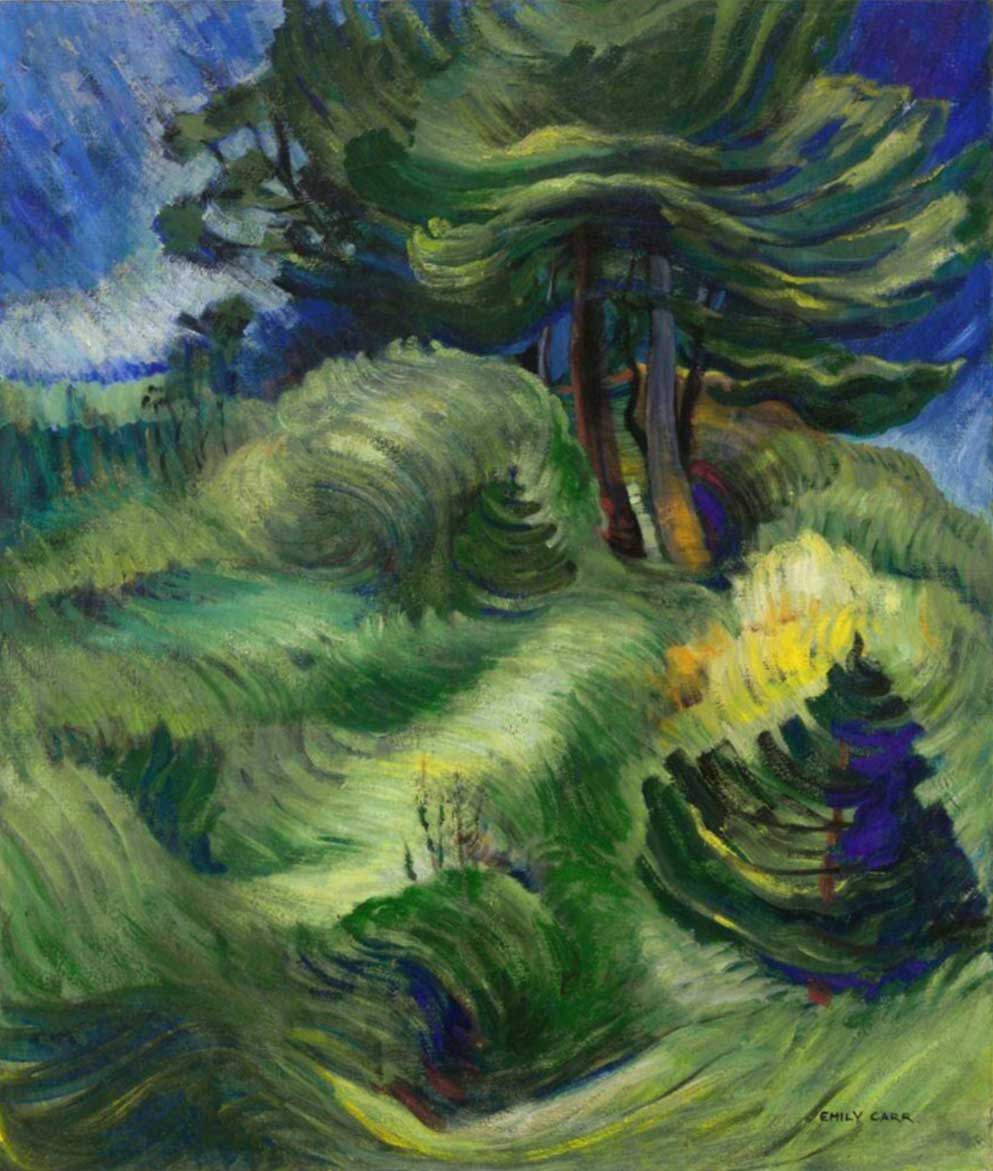
Color Palette of the Month
This month, I couldn’t help but be inspired by our Master Artist – Emily Carr. Emily captures the rich greens and earth tones of her beloved forests. These colors are so grounding and calming to our spirit. Combined with soothing sky tones and swirling brushstrokes her pieces invite you into the landscape, carrying you first into the woods and drawing your eyes up into the trees and sky beyond. So this month, we will revel in the abundance of color the earth has to offer. As always, if you are called to explore a different palette, please feel free.

“Nature always wears the colors of the spirit.”
– Ralph Waldo Emerson
Color Palette
Earth Artist PROMPT:
- What trees, plants or flowers do you most gravitate too? Identify these and make a list. Now spend some time drawing, sketching or collaging a page in your sketchbook dedicated to these. Then reflect – What do they mean to you? Why are you drawn to them?
Master Artist Guide
Emily Carr
This month I’m so very excited to bring you the work and story of Emily Carr. This artist was not one I learned about in Art School, in fact I only just discovered her recently in one of my new Art books. I had jotted her name down a few years ago as a potential artist for the Studioworks group. Then I promptly forgot about her and her work. Serendipitously, when I decided that we would focus on the element of Earth this month, along with a theme of the forest, her name jumped up off the page. I didn’t know why at the time, but went ahead and googled her work. I almost fell off my chair when I realized she mostly painted the forests of Northwest Canada! I took that as a sign to move forward with her and this theme for this month!
So let’s learn more about her together…
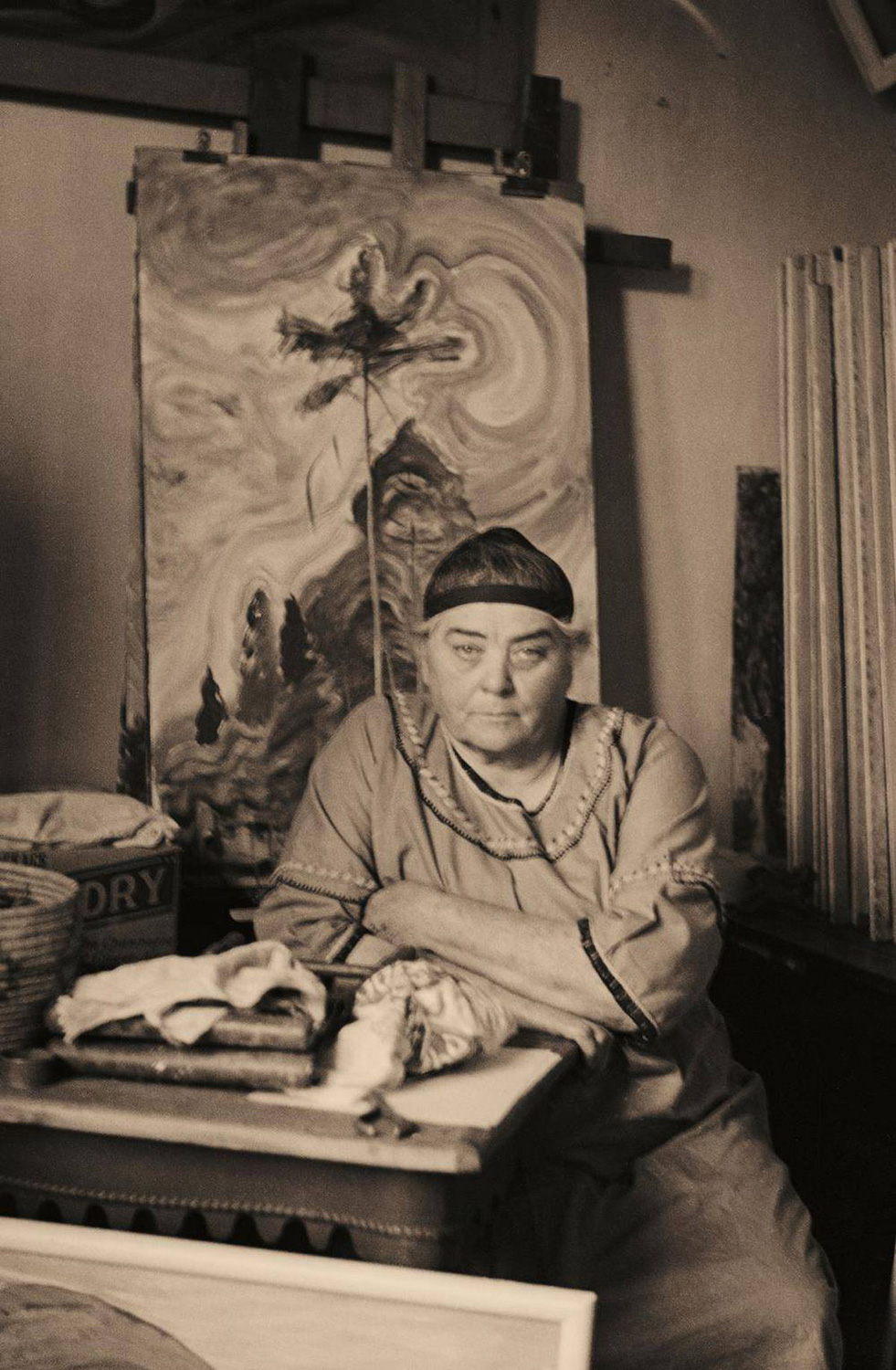
“What do these forests make you feel? Their weight and density, their crowded orderliness. There is scarcely room for another tree and yet there is space around each. They are profoundly solemn yet upliftingly joyous…”
– Emily Carr
OVERVIEW –Emily Carr (December 13, 1871 – March 2, 1945) was a Canadian artist and writer who was inspired by the Indigenous peoples of the Pacific Northwest Coast. One of the painters in Canada to adopt a Modernist and Post-Impressionist style, Carr did not receive widespread recognition for her work until she changed subject matter from Aboriginal themes to landscapes—forest scenes in particular. As a writer Carr was one of the earliest chroniclers of life in British Columbia. The Canadian Encyclopedia describes her as a “Canadian icon”.
Early Life
Born in Victoria, British Columbia, in 1871, the year British Columbia joined Canada, Emily Carr was the second-youngest of nine children born to English parents Richard and Emily Carr. The Carr home was on Birdcage Walk (now Government Street), in the James Bay district of Victoria, a short distance from the legislative buildings.
The Carr children were raised on English tradition. Her father believed it was sensible to live on Vancouver Island, a colony of Great Britain, where he could practice English customs and continue his British citizenship. The family home was made up in lavish English fashion, with high ceilings, ornate moldings, and a parlor. Carr was taught in the Presbyterian tradition, with Sunday morning prayers and evening Bible readings.

Emily Carr House, Government Street, Victoria – now a Cultural Heritage Site
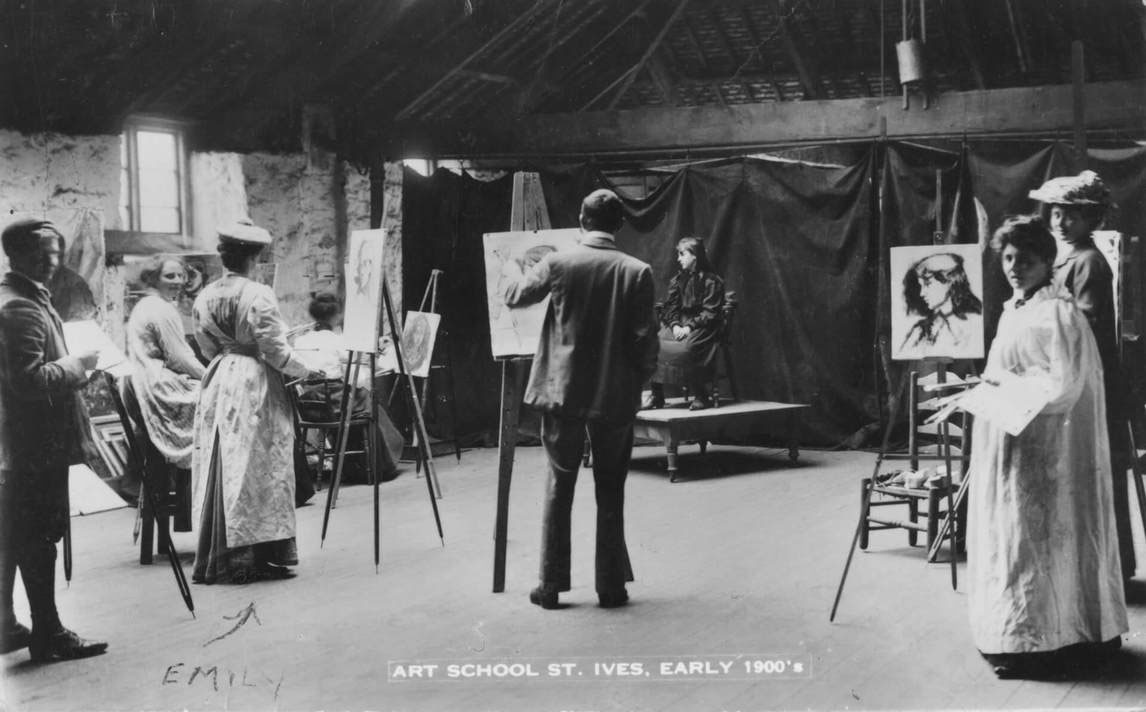
Students painting from life at the art school in St. Ives in the early 1900s. Carr is on the left with her back to the camera, wearing a hat and an apron.
Carr’s mother died in 1886, and her father died in 1888. Her oldest sister Edith Carr became the guardian of the rest of the children.
Carr’s father had encouraged her artistic inclinations, but it was only in 1890, after her parents’ deaths, that Carr pursued her art seriously. She studied at the San Francisco Art Institute for two years (1890–92) before returning to Victoria. In 1899, Carr traveled to London, where she studied at the Westminster School of Art. Carr also visited the Nootka Indian mission at Ucluelet on the west coast of Vancouver Island in 1898. She also traveled to a rural art colony in St Ives, Cornwall, returning to British Columbia in 1905
Carr’s father had encouraged her artistic inclinations, but it was only in 1890, after her parents’ deaths, that Carr pursued her art seriously. She studied at the San Francisco Art Institute for two years (1890–92) before returning to Victoria. In 1899, Carr traveled to London, where she studied at the Westminster School of Art. Carr also visited the Nootka Indian mission at Ucluelet on the west coast of Vancouver Island in 1898. She also traveled to a rural art colony in St Ives, Cornwall, returning to British Columbia in 1905.
Carr took a teaching position in Vancouver at the ‘Ladies Art Club’ that she held for no longer than a month – she was unpopular amongst her students due to her rude behavior of smoking and cursing at them in class, and the students began to boycott her courses.
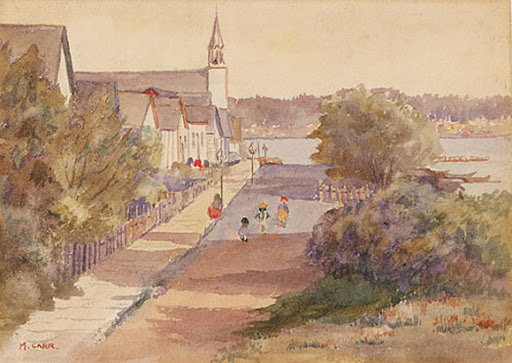
Indian Reserve, North Vancouver, 1905
First works on Indigenous people
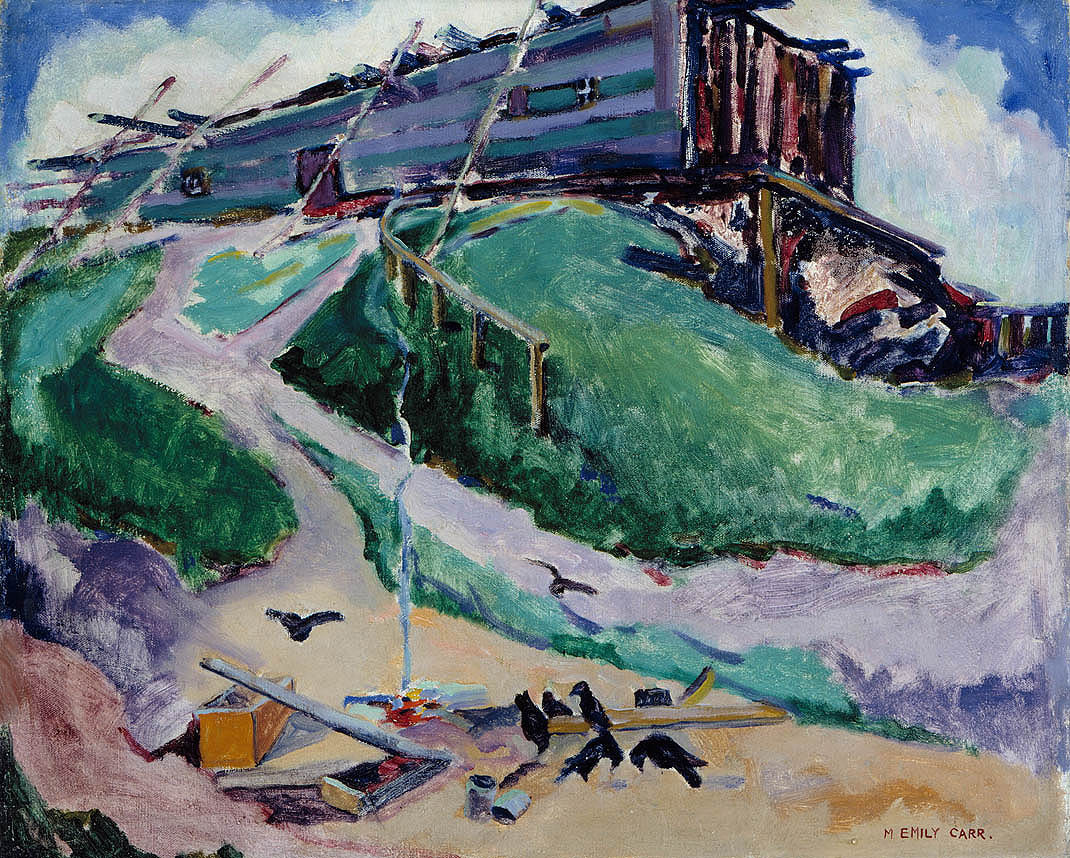
Community House, Ucluelet, 1912
In 1898, at age 27, Carr made the first of several sketching and painting trips to Aboriginal villages. She stayed in a village near Ucluelet on the west coast of Vancouver Island, home to the Nuu-chah-nulth people, then commonly known to English-speaking people as ‘Nootka’. Carr recalled that her time in Ucluelet made “a lasting impression on me”. Her interest in Indigenous life was reinforced by a trip to Alaska nine years later with her sister Alice. In 1912, Carr took a sketching trip to First Nations’ villages in Haida Gwaii, the Upper Skeena River, and Alert Bay. Even though Carr left the villages of the Pacific Northwest, the impact of the people stayed with her. Carr was given an Indigenous name – Klee Wyck – by members of the Nuu-chah-nulth First Nation, meaning “Laughing One.” (meaning Laughing One) and she also chose it as the title of one of her works of writings.
Work in France
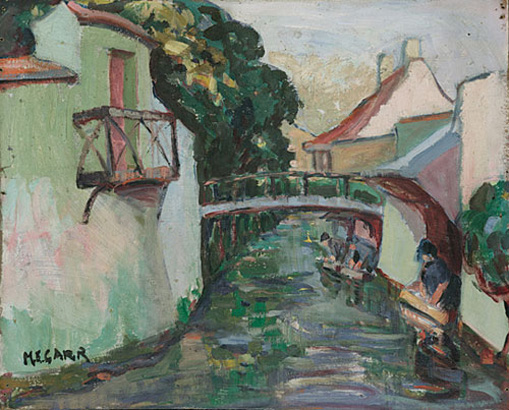
Crécy-en-Brie, 1911
Determined to further her knowledge of the evolving artistic trends, in 1910 Carr returned to Europe to study at the Académie Colarossi in Paris. In Montparnasse with her sister Alice, Emily Carr met modernist painter Harry Gibb with a letter of introduction. Upon viewing his work, she and her sister were shocked and intrigued by his use of distortion and vibrant color; she wrote: “Mr Gibb’s landscapes and still life delighted me — brilliant, luscious, clean. Carr’s study with Gibb and his techniques shaped and influenced her style of painting, and she adopted a vibrant color palette rather than continuing with the pastel colors of her earlier British training.
Carr was greatly influenced by the Post-Impressionists and the Fauvists she met and studied with in France. After returning home in 1912, she organized an exhibition in her studio of seventy watercolors and oils representative of her time there. She was the first artist to introduce Fauvism to Vancouver.
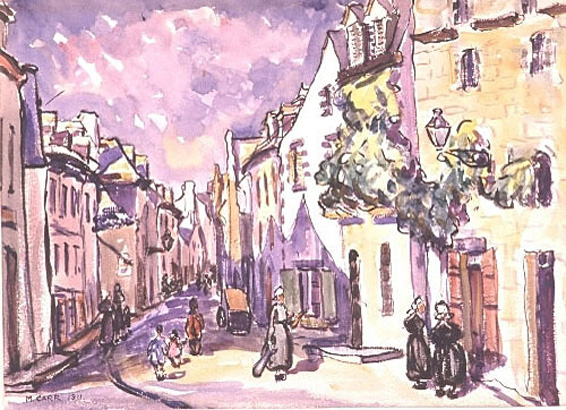
Street in Brittany, 1911
Return to Canada
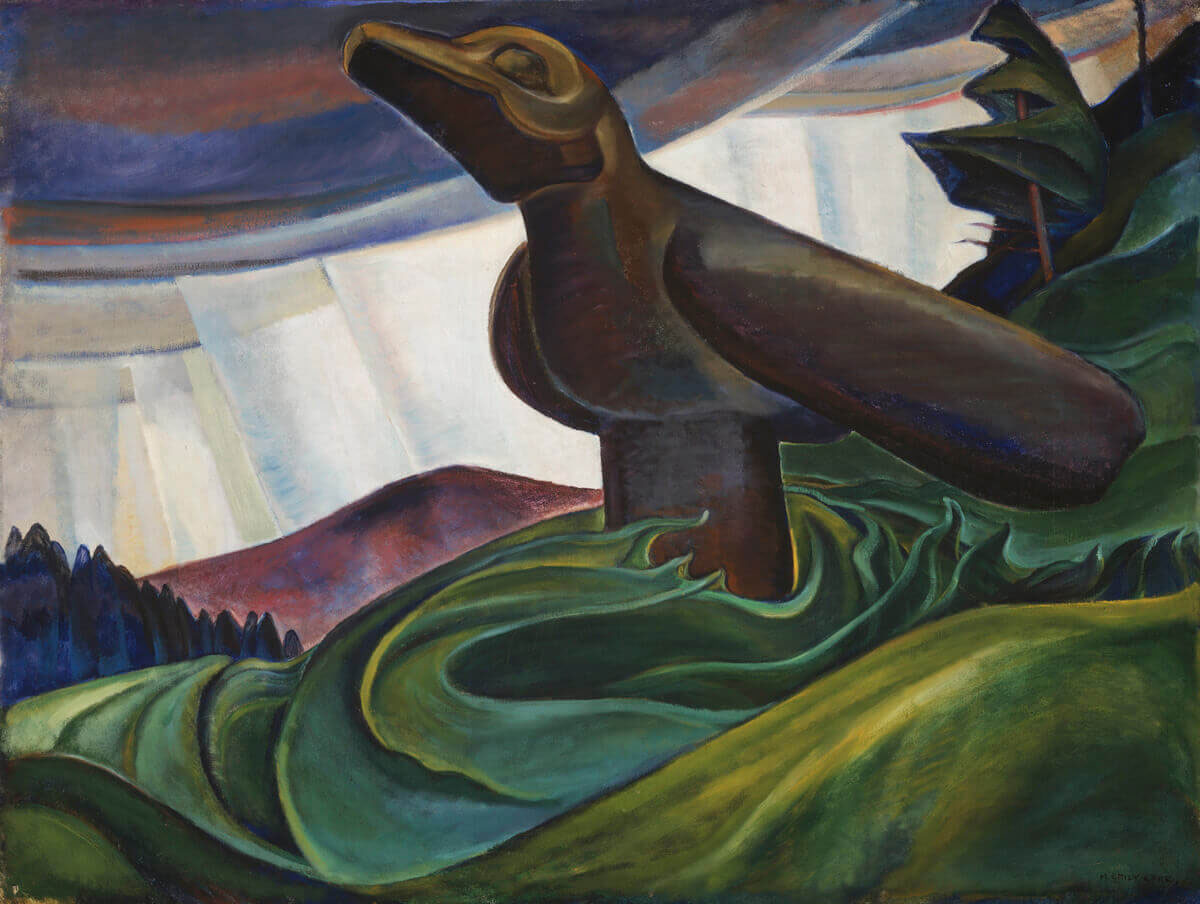
Big Raven, 1931
In March 1912, Carr opened a studio at 1465 West Broadway in Vancouver. When locals failed to support her radical new style, bold color palette and lack of detail, she closed the studio and returned to Victoria. In the summer of 1912, Carr again traveled north, to Haida Gwaii and the Skeena River. At Cumshewa, a Haida village on Moresby Island, she wrote:
“Cumshewa seems always to drip, always to be blurred with mist, its foliage always to hang wet-heavy. These strong young trees … grew up round the dilapidated old raven, sheltering him from the tearing winds now that he was old and rotting … the memory of Cumshewa is of a great lonesomeness smothered in a blur of rain.”
Carr painted a carved raven, which she later developed as her iconic painting Big Raven. Tanoo, another painting inspired by work gathered on this trip, depicts three totems before house fronts at the village of the same name. On her return to the south, Carr organized an exhibit of some of this work. She gave a detailed lecture about the Aboriginal villages that she had visited, which ended with her mission statement:
“I glory in our wonderful west and I hope to leave behind me some of the relics of its first primitive greatness. These things should be to us Canadians what the ancient Briton’s relics are to the English. Only a few more years and they will be gone forever into silent nothingness and I would gather my collection together before they are forever past.”
While there was some positive reaction to her work, even in the new ‘French’ style, Carr perceived that Vancouver’s reaction to her work and new style was not positive enough to support her career. She recounted as much in her book Growing Pains. She was determined to give up teaching and working in Vancouver, and in 1913 she returned to Victoria, where several of her sisters still lived.
During the next 15 years, Carr did little painting. She ran a boarding house known as the ‘House of All Sorts’. It was the namesake and provided source material for her later book. With her financial circumstances straitened and her life in Victoria circumscribed, Carr painted a few works in this period drawn from local scenes: the cliffs at Dallas Road, the trees in Beacon Hill Park.
Along the Cliff, Beacon Hill, 1919
Growing recognition
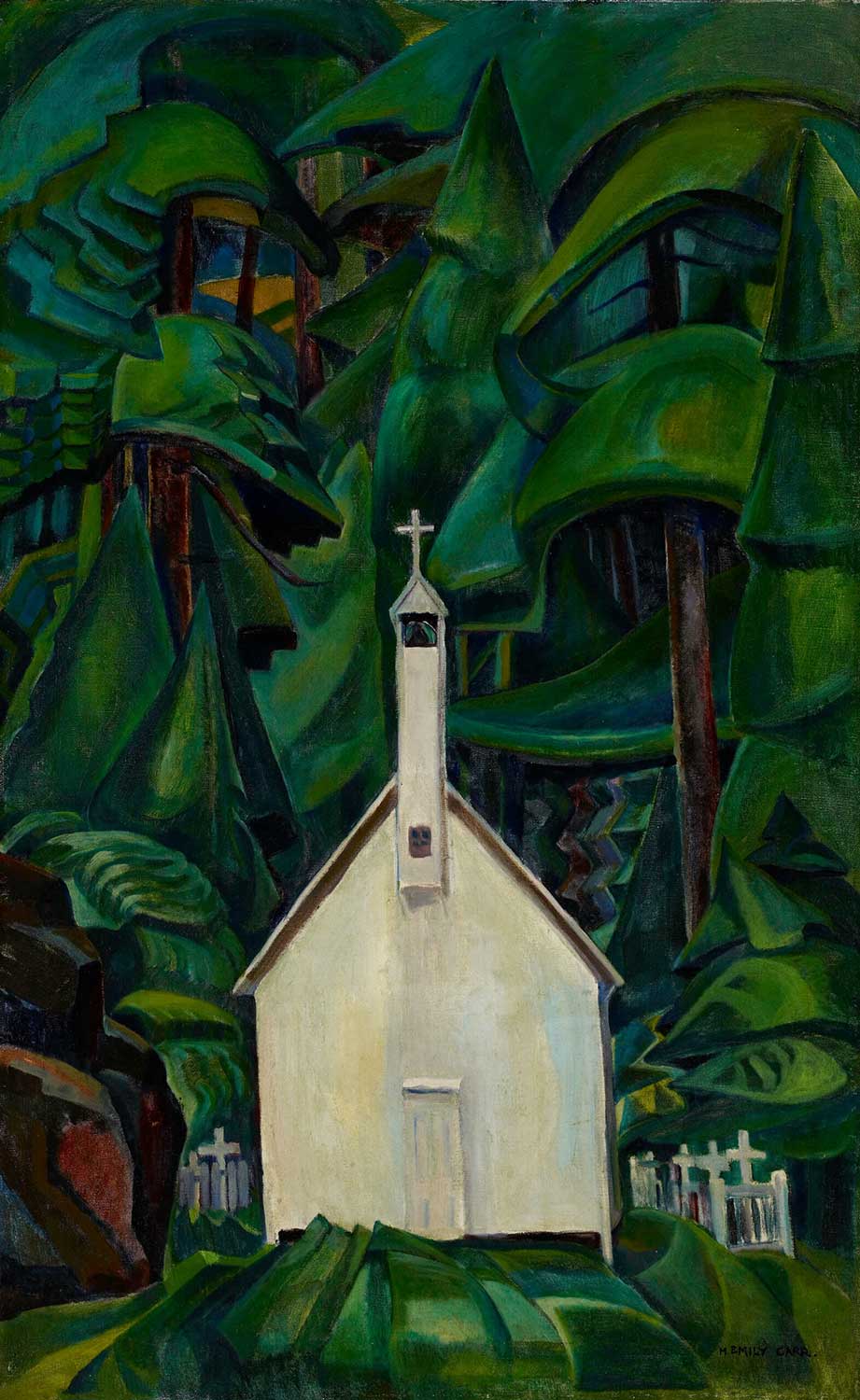
Indian Church, 1929
Over time Carr’s work came to the attention of several influential and supportive people, including Marius Barbeau, a prominent ethnologist at the National Museum in Ottawa. Barbeau in turn persuaded Eric Brown, Director of Canada’s National Gallery, to visit Carr in 1927. Brown invited Carr to exhibit her work at the National Gallery as part of an exhibition on West Coast Aboriginal art. Carr sent 26 oil paintings east, along with samples of her pottery and rugs with Indigenous designs. The exhibit, which also included works by Edwin Holgate and A.Y. Jackson, traveled to Toronto and Montreal.
Carr continued to travel throughout the late 1920s and 1930s away from Victoria. Her last trip north was in the summer of 1928, when she visited the Nass and Skeena rivers, as well Haida Gwaii, formerly known as the Queen Charlotte Islands. Recognition of her work grew steadily, and her work was exhibited in London, Paris, Washington, DC, and Amsterdam, as well as major Canadian cities.Carr held her first solo show in eastern Canada in 1935 at the Women’s Art Association of Canada gallery in Toronto.
Association with the Group of Seven
It was at the exhibition on West Coast Aboriginal art at the National Gallery in 1927 that Carr first met members of the Group of Seven, at that time Canada’s most recognized modern painters. Lawren Harris of the Group became a particularly important support: “You are one of us,” he told Carr, welcoming her into the ranks of Canada’s leading modernists. The encounter ended the artistic isolation of Carr’s previous 15 years, leading to one of her most prolific periods, and the creation of many of her most notable works. Through her extensive correspondence with Harris, Carr also became aware of and studied Northern European symbolism.
Carr’s artistic direction was influenced by the Group, and by Lawren Harris in particular, not only by his work, but also by his belief in Theosophy. Carr struggled to reconcile this with her own conception of God. Carr’s “distrust for institutional religion” pervades much of her art. She became influenced by Theosophic thought, like many artists of the time, and began to form a new vision of God as nature. She led a spiritual way of life, rejecting the Church and the religious institution. She painted raw landscapes found in the Canadian wilderness, mystically animated by a greater spirit.
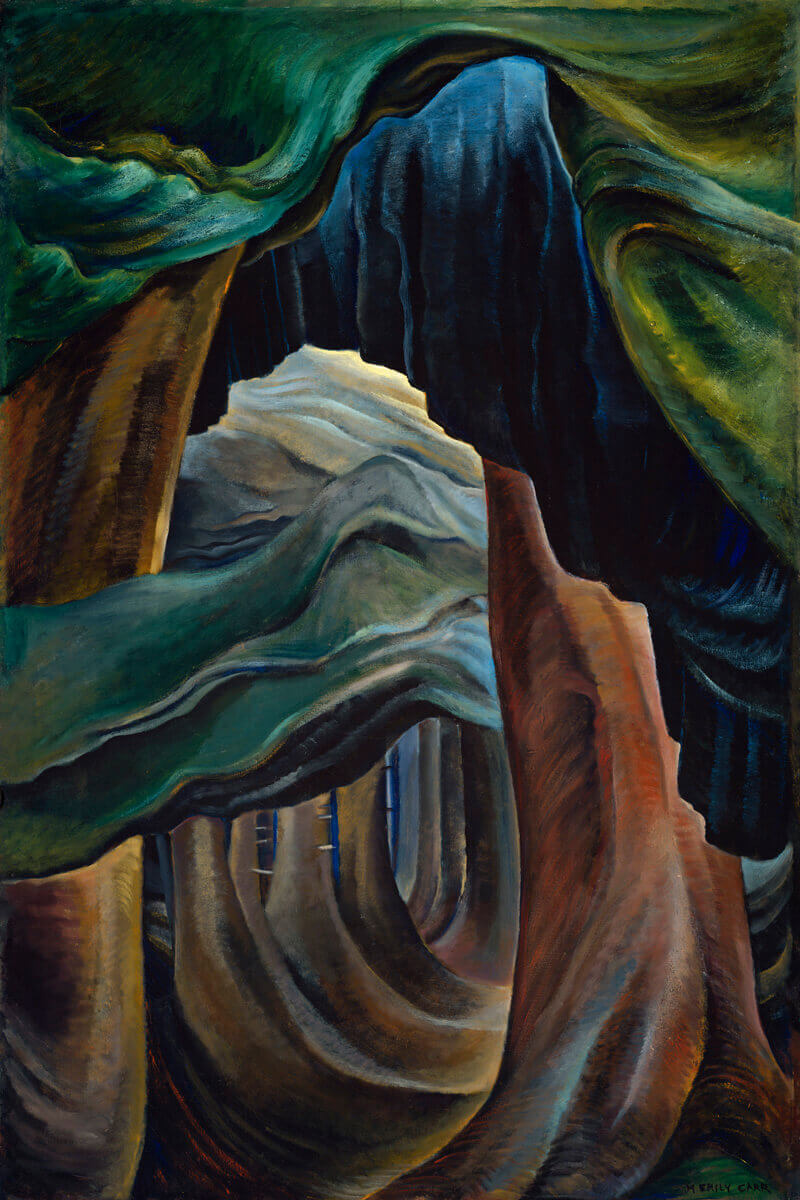
Forest B.C., 1931-32
“What does spirituality in painting mean? First, the seeing beyond the form to the spiritual reality underlying it—its meaning.”
– Emily Carr
Focus shift and late life
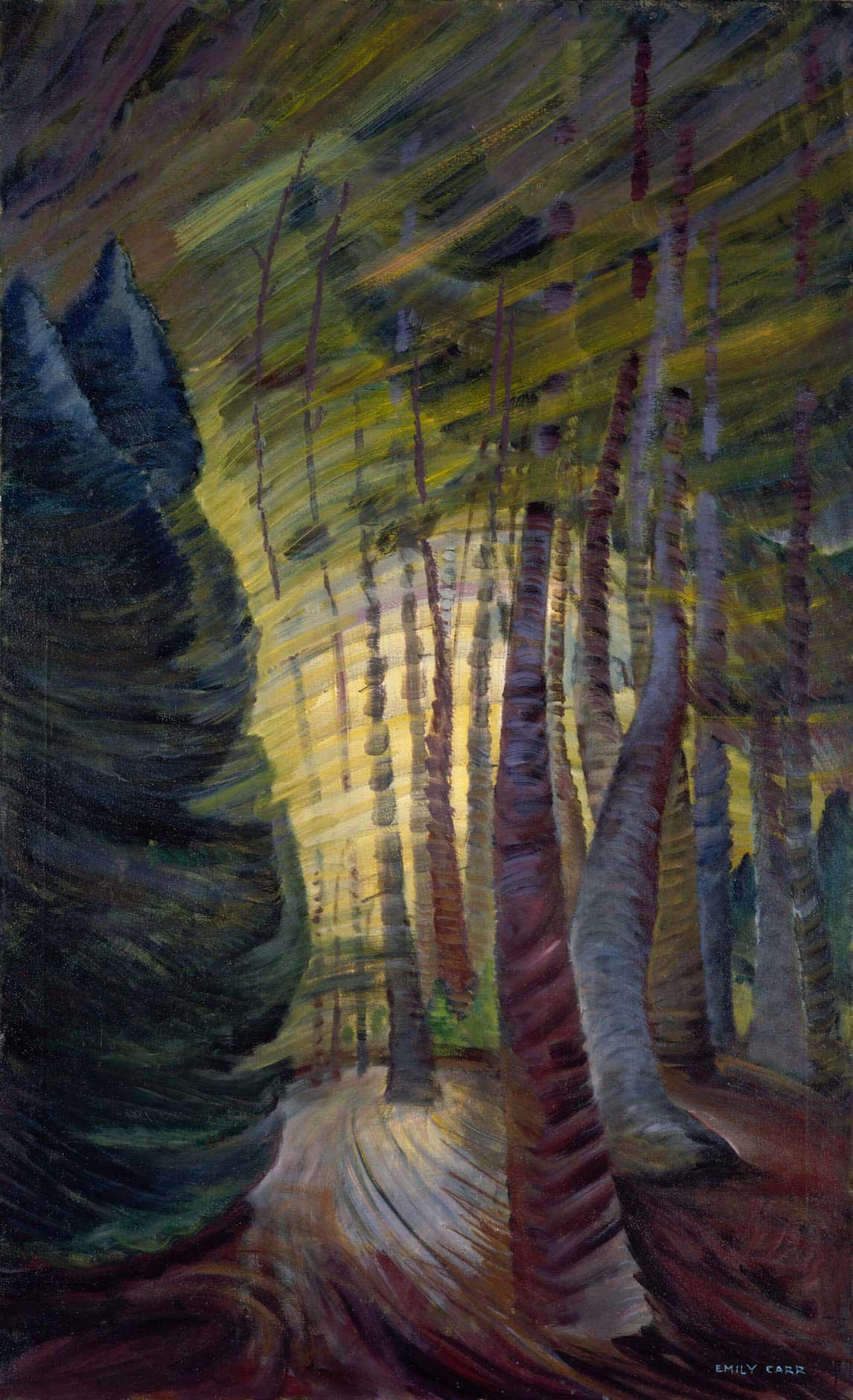
Sombreness Sunlit, c. 1938–40
Carr suffered a heart attack in 1937, and another in 1939, forcing her to move in with her sister Alice to recover. In 1940 Carr suffered a serious stroke, and in 1942 she had another heart attack. With her ability to travel curtailed, Carr’s focus shifted from her painting to her writing. The editorial assistance of Carr’s friend Ira Dilworth, a professor of English, enabled Carr to see her own first book, Klee Wyck, published in 1941. Carr was awarded the Governor-General’s Award for non-fiction the same year for the work.
Paintings from Carr’s last decade reveal her growing anxiety about the environmental impact of industry on British Columbia’s landscape. Her work from this time reflected her growing concern over industrial logging, its ecological effects and its encroachment on the lives of Indigenous people. In her painting, Odds and Ends, from 1939 “the cleared land and tree stumps shift the focus from the majestic forestscapes that lured European and American tourists to the West Coast to reveal instead the impact of deforestation.
Emily Carr suffered her last heart attack and died on March 2, 1945, at the James Bay Inn in her hometown of Victoria, British Columbia, shortly before she was to have been awarded an honorary doctorate by the University of British Columbia. Carr is buried at Ross Bay Cemetery.
“I think that one’s art is a growth inside one. I do not think one can explain growth. It is silent and subtle. One does not keep digging up a plant to see how it grows.”
– Emily Carr
ENJOY THIS SLIDESHOW OF SOME OF HER WORK…
Here’s a Pinterest board full of her work to inspire you!
Read more about Emily Carr below:
Master Artist Guide
Sketchbook Explorations
EXPLORATION 1
Emily Carr inspired
As always, our Master Artist has inspired me so let’s do a Master Study of one of her works OR do a work inspired by her style. Have fun with this! Take note of her swirling, directional brush strokes and continual subject of trees, forests and landscape. Remember, this isn’t about creating an exact replica of her work but more about feeling into how she worked and what inspired her. Emily often used watercolors or oils but use whatever medium feels good to you! I was very inspired by a statue we have in our garden. I then incorporated the trees around her to create my painting in a Emily Carr inspired way…
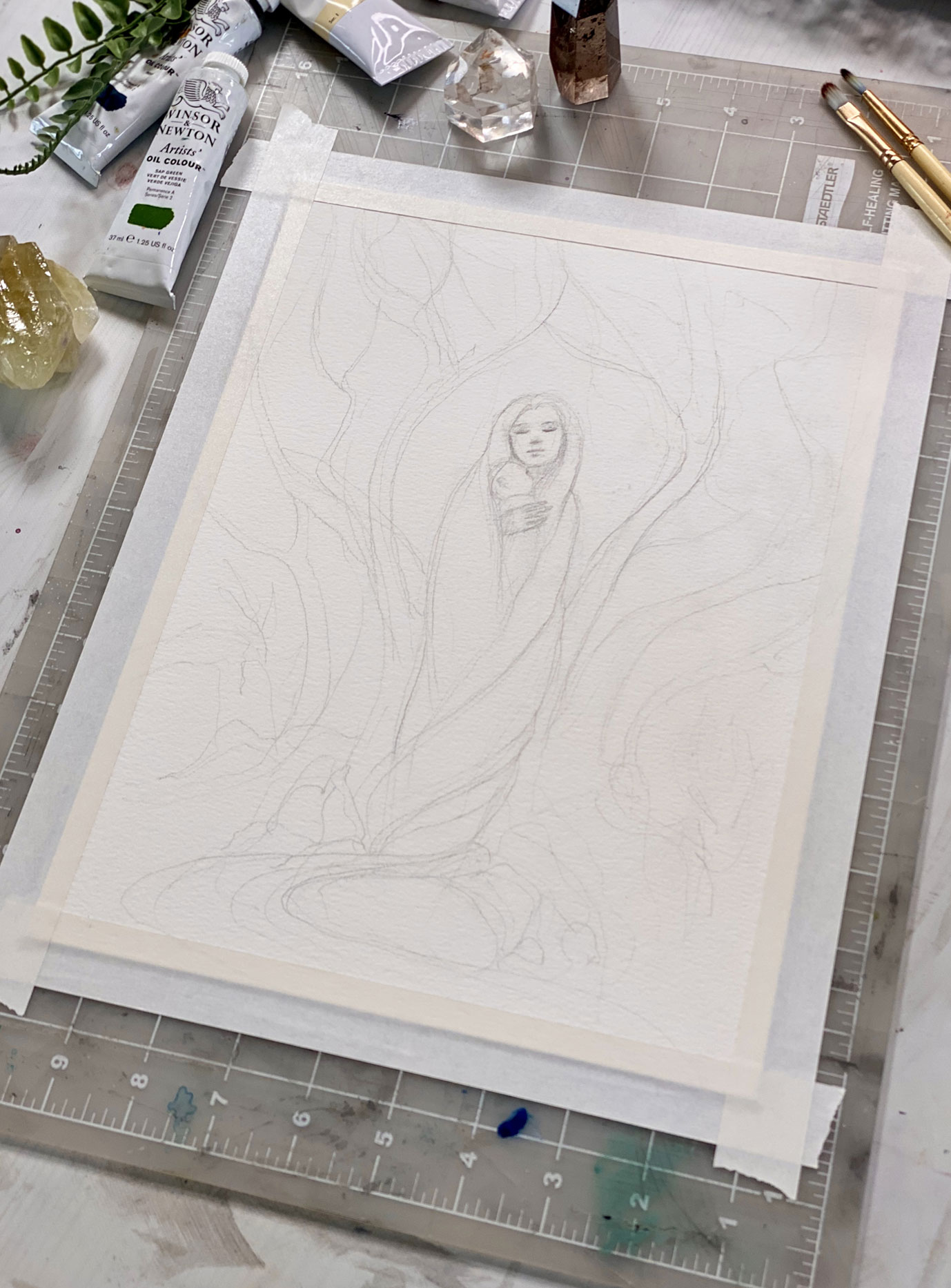
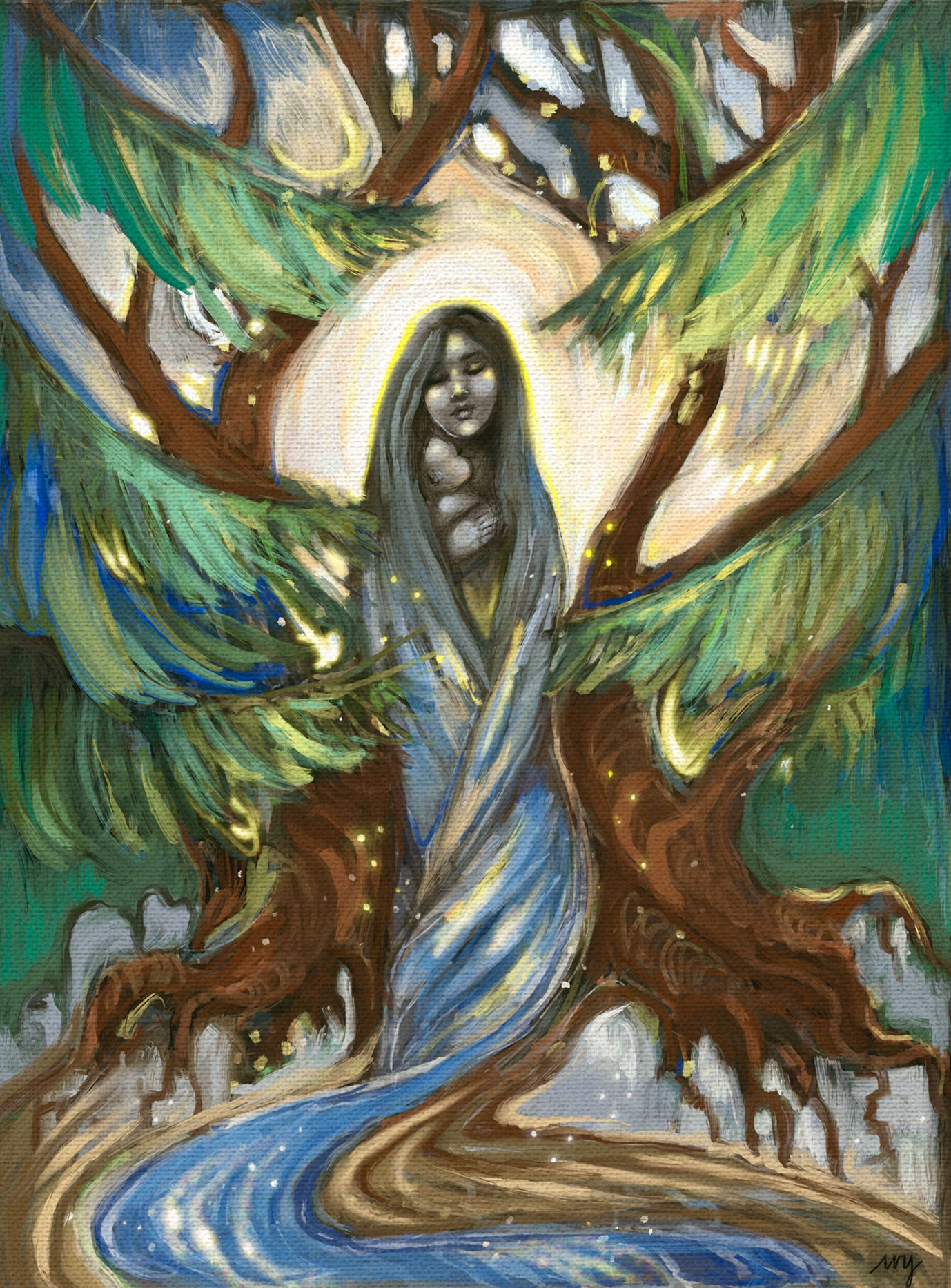
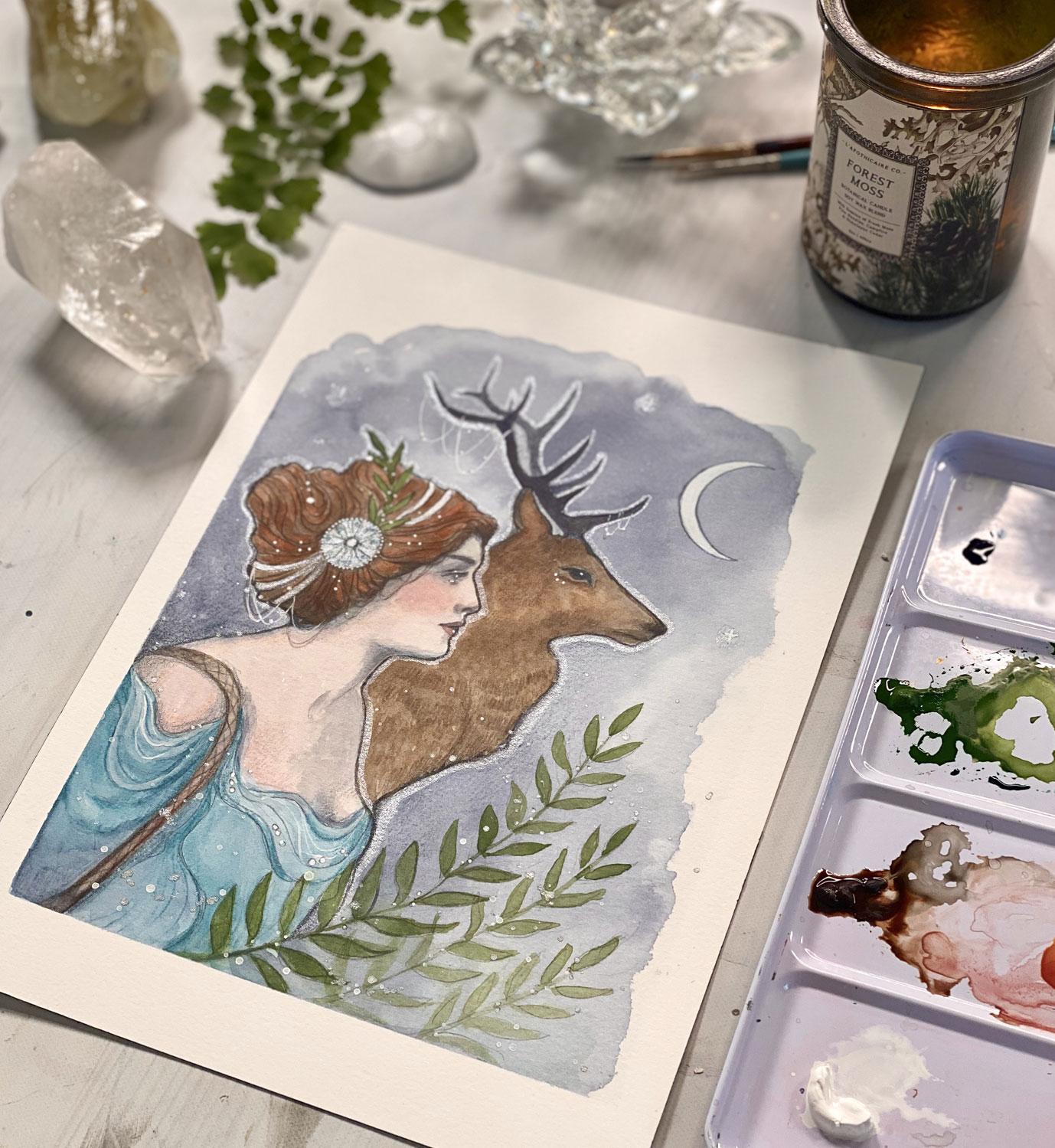
EXPLORATION 2
Earth Goddess
Create a sketch, collage, journal page or painting dedicated to an Earth Goddess of your choice. Let the symbols, colors and messages from this Goddess inspire you! I loved creating my Artemis. You will see what reference images I worked from below.
EXPLORATION 3
Emily Carr inspired
So often we can get intimidated by drawing from life and when we look at complex structures like trees we may shy away from the practice. So to disarm this feeling, let’s do some blind contour drawings of trees. Emily Carr reportedly did this too! Go out in nature and find a tree that you are drawn to. Using a pen, pencil or stick of charcoal gaze up at the tree and allow your hand to freely record what your eyes see without looking down at the page. Yes, this will feel a bit silly and might give you some pretty wonky results but that’s kind of the point. Do several of these! See if you can capture the essence of the tree rather than it’s exact form. This can be a great way to start an expressive abstract painting!
“Go out, go out I beg of you. And taste the beauty of the wild. Behold the miracle of the earth. With all the wonder of a child.”
– Enda Jaques
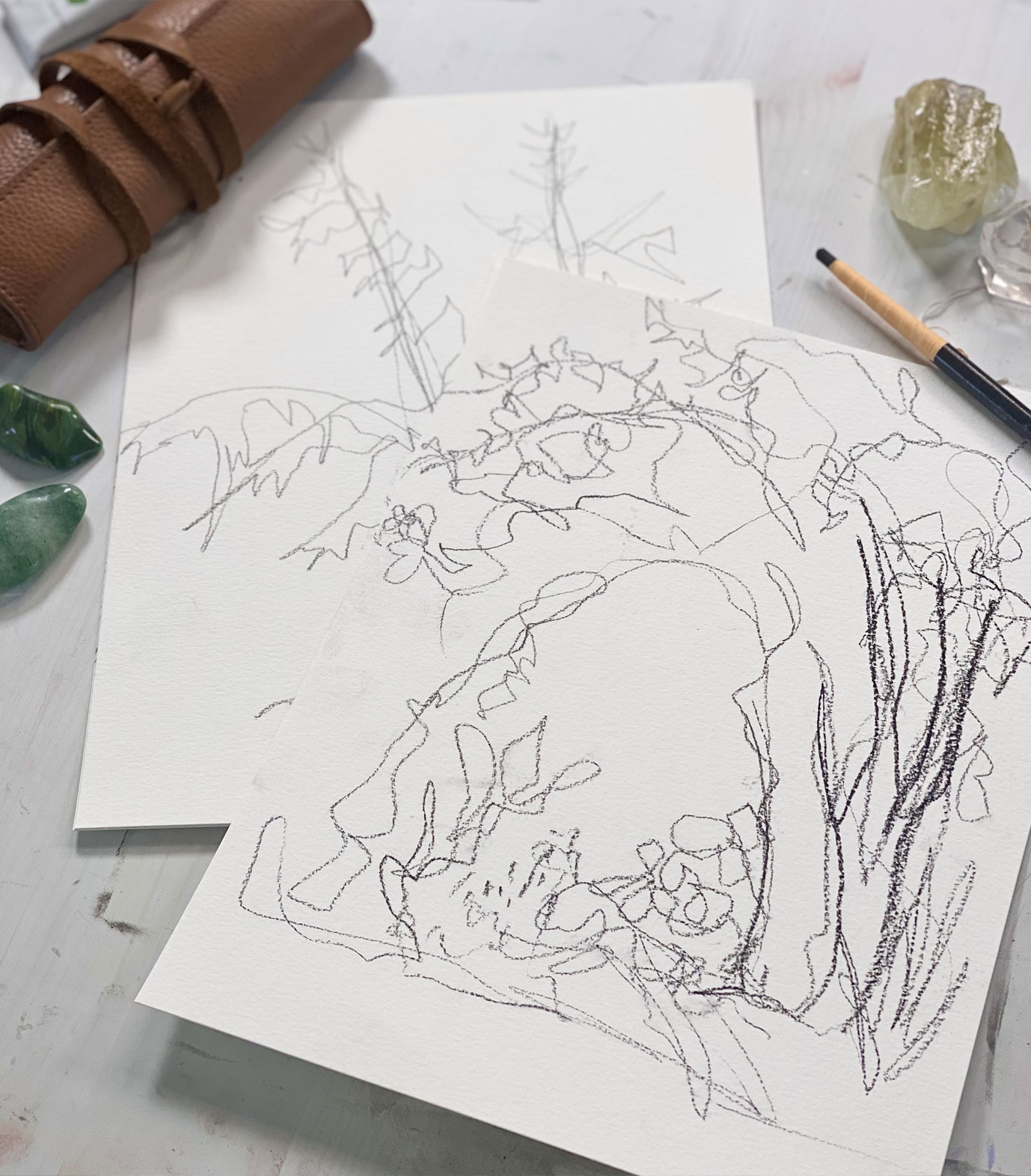
MONTHLY ART LESSONS
with Rachel Juanita Bellamy
& Petra Hrziwnatzki
So very delighted to share two beautiful lessons from some of our beloved teachers – Rachel Juanita Bellamy and Petra Hrziwnatzki.
Rachel has a heartfelt, art journaling lesson for us. She found grounding, comfort and inspiration from the Earth and her deep faith. Her mark making and layering of mediums is so lovely! And Petra, guides us through a wonderful sculpting lesson where we can truly honor Mother Earth by working with her treasured medium – clay! Enjoy!
STUDIOWORKS
Submission Calls
If you’d like to be featured in an upcoming Studioworks Journal, we’d love to have you join our Creative Network! Our intention with Studioworks has always been to cultivate community involvement and collaboration. Featuring members from our creative community is such an honor and a beautiful way to share the light you all bring. Come join us!
STUDIOWORKS PODCAST
issue thirty-two
You can also listen to this month’s issue of the Studioworks journal. I find I love listening to books, podcasts and music while I draw, paint or go on a long walk. Enjoy.
Studioworks : issue thirty-two
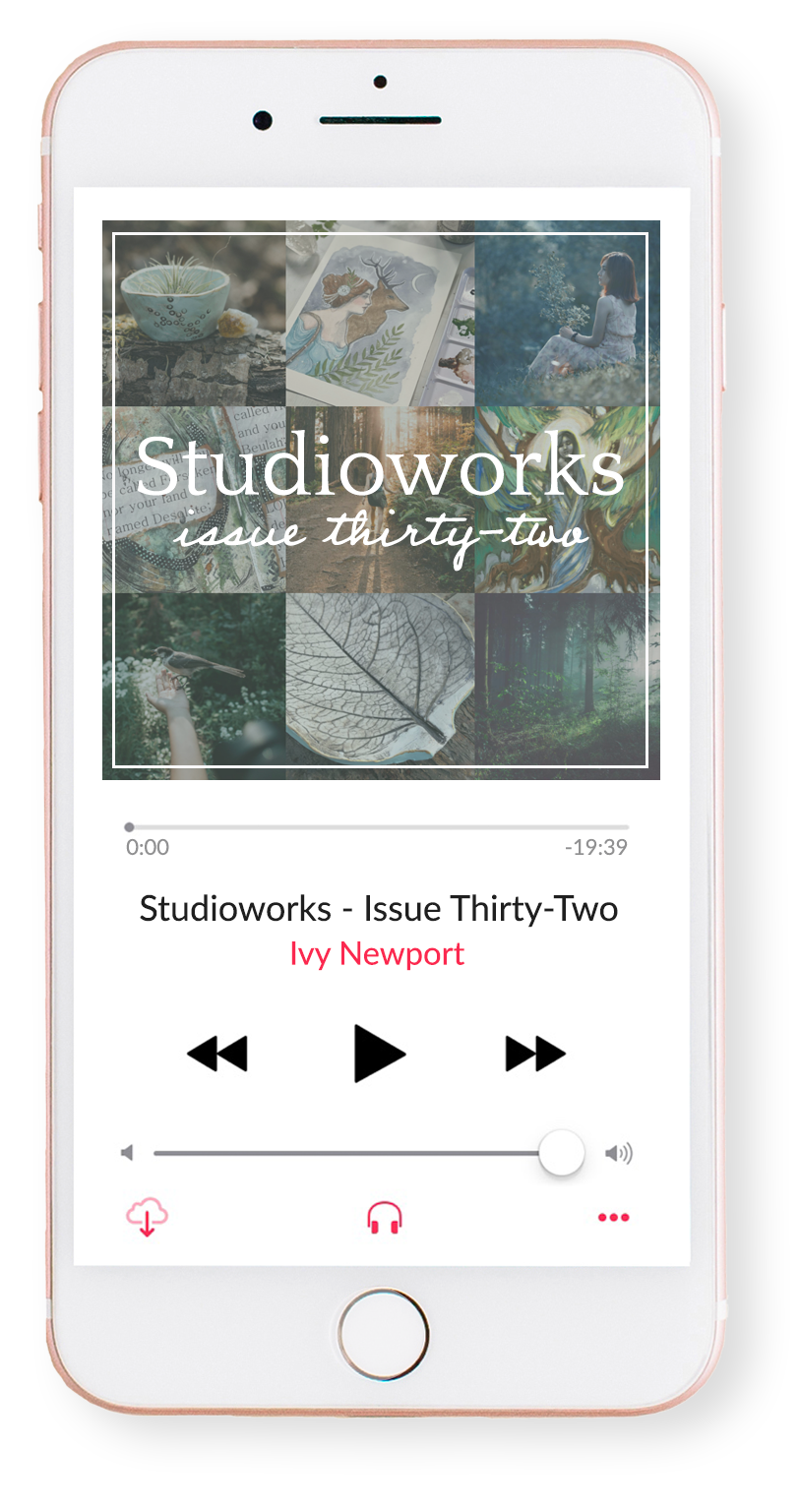
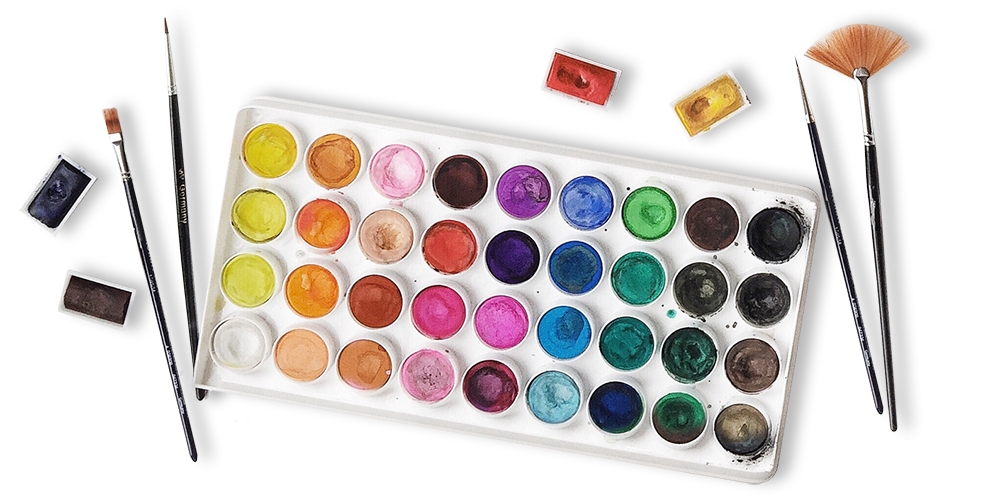
inspiration: curated
Books to Discover & Enjoy
MUSIC PLAYLIST
I had so much fun curating this list. I hope you enjoy!!
THINGS TO WATCH
PINTEREST BOARDS
CLASSES TO TRY
Here are just a few of our fantastic classes! They feel in alignment with this month’s issue! I highly recommend checking them out if you haven’t already. Enjoy!

